CWWK Q670 Gen 5 NAS Board Review
With so, SO many DIY mini server motherboards in the market, what exactly does the $200 CWWK Q670 NAS motherboard bring to the party that we haven’t seen dozen times before? The booming market for 24×7 server mobos in ‘M-ITX in the last 18-24 months has been somewhat meteoric, with Chinese brands such as CWWK and Topton gaining a lot of industry attention for providing versatile solutions that challenge the hardware power and value that we have come to expect. The CWWK Q670 certainly continues this trend, arriving as a M-ITX motherboard that is ready for the slowly rolling out 14th Gen of Intel CPUs (as well as 12 and 13th Generation), Gen 5 PCIe architecture, DDR5 memory in the triple figures, eight native SATA drives and three m.2 NVMes SSDs (covering Gen5x4 and at 22110 length too). There is ALOT here on this little board. But power isn’t everything! How does it all come together? Have compromises been made? And ultimately, does it deserve your data? Let’s find out whether the Q670 deserves to find a home in your homelab.
Important Note – The photos taken for this article were taken AFTER I installed a CPU, Memory and heatsink. The default $200+ model of the CWWK Q670 arrives without any kind of extras.

| Component | Details |
|---|---|
| Form Factor | Mini-ITX (17 cm x 17 cm, 6.7-in x 6.7-in) |
| Chipset | Intel Q670 |
| Supported CPUs | Intel 12th/13th/14th Generation LGA1700 desktop processors |
| Memory Technology | Desktop U-DIMM DDR5 |
| Memory Slots | 2* U-DIMM DDR5 dual channel |
| Memory Speed | DDR5 supports 5600MHz by default (12th gen processors only support 4800MHz) |
| Max Memory Capacity | Single memory maximum 96GB; two memories maximum 192GB |
| M.2 Slots | 1* M.2 NVMe PCIe 5.0 x4 (2280/22110 size, front of motherboard) |
| 2* M.2 NVMe PCIe 4.0 x4 (2280 size, back of motherboard) | |
| SATA Ports | 8* SATA 3.0 (6Gbps) |
| Network Ports | 1* Intel i226-V 2.5G RJ45 |
| 1* Intel i226-LM 2.5G RJ45 (supports Intel vPro remote management function) | |
| Expansion Slots | 1* PCI-E x16 (PCIe 5.0 x16 signal) supports graphics card/network card expansion |
| Display Outputs | 1* HDMI 2.0 (supports 4K 4096×2160 @ 60Hz) |
| 1* DP 1.4 (supports 4K 4096×2160 @ 60Hz) | |
| 1* D-Sub (supports 1080P 1920×1200 @ 60Hz) | |
| USB Ports | 2* USB 2.0 Type-A (rear) |
| 2* USB 3.2 Gen 1 Type-A (rear) | |
| 1* USB 3.2 Gen 2 Type-C (rear) | |
| 2* USB 3.2 Gen 1 Type-A (via header) | |
| 1* USB 3.2 Gen 2 Type-C (via header) | |
| 2* USB 2.0 Type-A (via header) |
|
Where to Buy? |
CWWK Q670 NAS Board Review – Quick Conclusion
As long as you do not lose sight of the fact that the CWWK Q670 NAS mobo is designed to be part of a larger and more powerful NAS build, there is ALOT to love here – especially at 200 bucks! For an M-ITX board this thing out specs a lot of bigger and broader M-ATX boards at the price. The Gen 5 architecture, if you are going to build around it ‘hardcore’ enough, as well as spend the time needed to tweak it, is definitely this board’s USP. As is that it manages to challenge conceptions of what an MITX board should arrive with, thanks to those eight native SATA ports. The remote BIOS-level access is a nice extra and although its not going to be used by everyone, in a pinch (ie ‘back against the wall troubleshooting and/or maintenance), it’s a great little bonus. The huge scalability afforded to the NAS builders with the UDIMM memory choice over SODIMM and three M.2s really does allow for a much more aggressively storage-focused system here. All that said, things are super cramped here and extra care is advised when buying your accessories (especially cooling), as aside from airflow restrictions, there is the potential here to accidentally create a air flow dead end! This is NOT a motherboard for the learner homelab’er or shiny new NAS enthusiast… but if you are happy to spend a little more and have the time to configure accordingly, this thing can be a fricking POWERHOUSE!
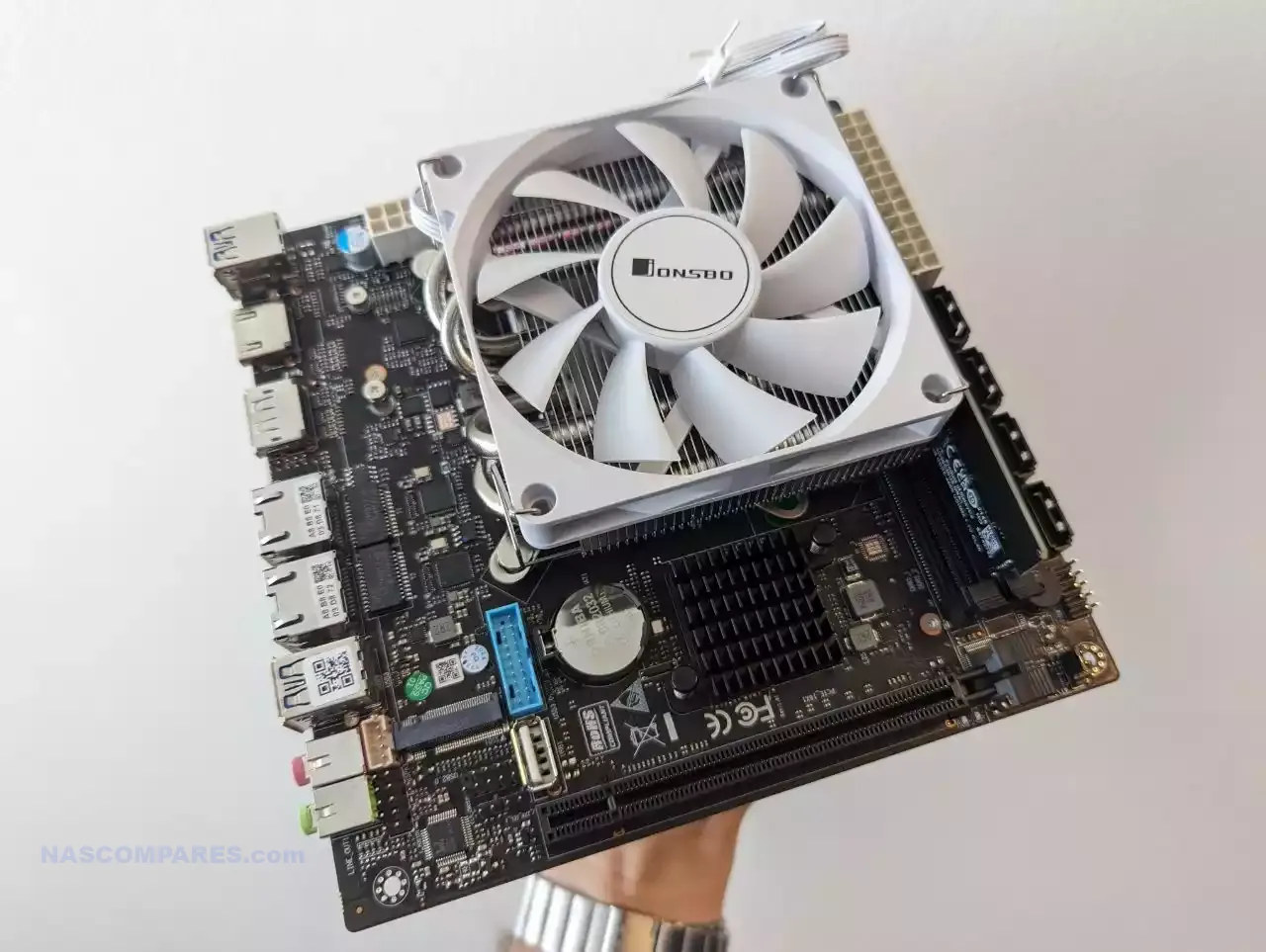
Where to Buy a Product





![]()
![]()

VISIT RETAILER ➤






![]()
![]()

VISIT RETAILER ➤






![]()
![]()

VISIT RETAILER ➤






![]()
![]()

VISIT RETAILER ➤
 DEAL WATCH – Is It On Offer Right Now? DEAL WATCH – Is It On Offer Right Now?These Offers are Checked Daily
|
CWWK Q670 Gen 5 NAS Board Review – Design and Hardware
Although I set up the CWWK Q670 NAS motherboard with a 12th Gen i5 processor, it’s worth highlighting that this board supports all the way up to the latest 14th Gen of Intel Core processors (no mean feat, given their launch very late last year and very few mobos of this scale being compatible without significant compromise. Bring an M-ITX does mean that there are architectural compromises of course (more on that later) but they do manage to squeeze ALOT in here (for good, and for bad).
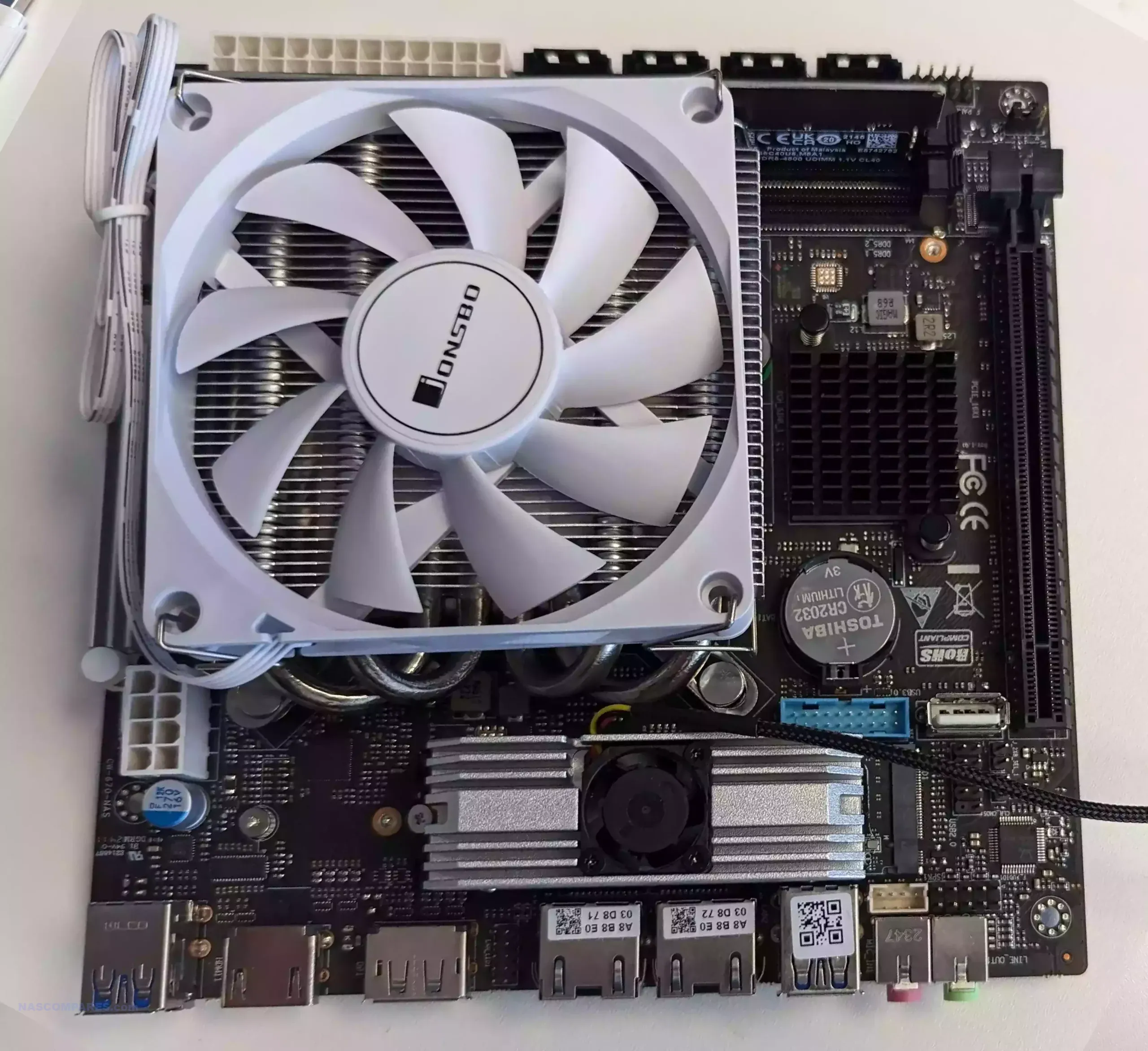
It’s also worth touching on that there are 2 versions of the 670, with a remote access network card that allows the end user to access system control and bios level customization over the network via Intel vPro and Intel EMA remotely. It’s quite a niche service for anything less than enterprise/bigger-business use, but its an incredibly useful feature for those that do not have the time or physical deployment for keyboard, Video & Mouse. This service is bound to one of the 2.5G ports, and does not prevent it for typical LAN use by the NAS system.
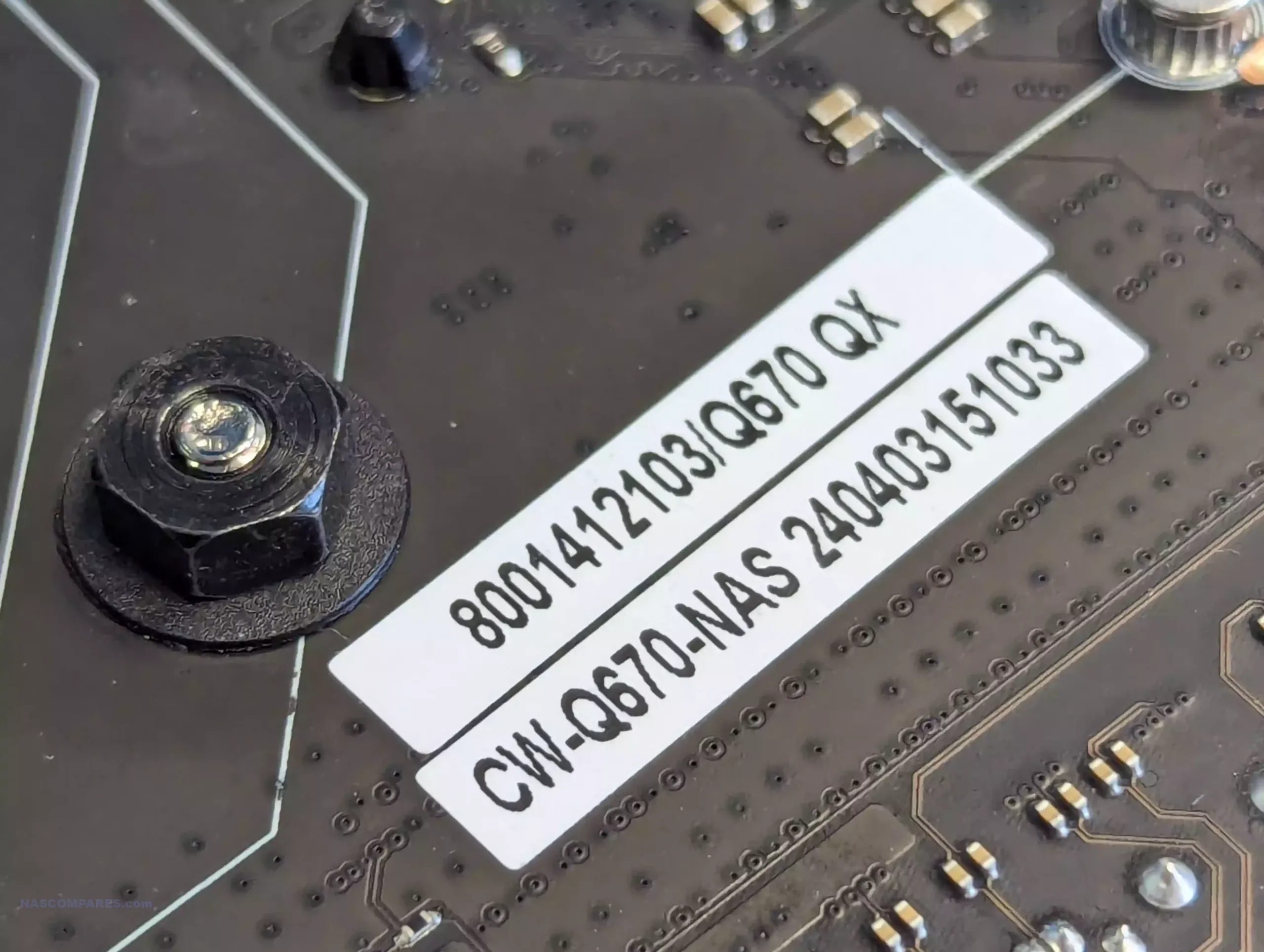
The CPU and cooler requirements are LGA1700 and the rear of the Q670 is a clean layout, and CWWK have used this spec to include two Gen4 M.2 slots (more eon these later), but we have to talk about something far more intriguing in this M-ITX board…
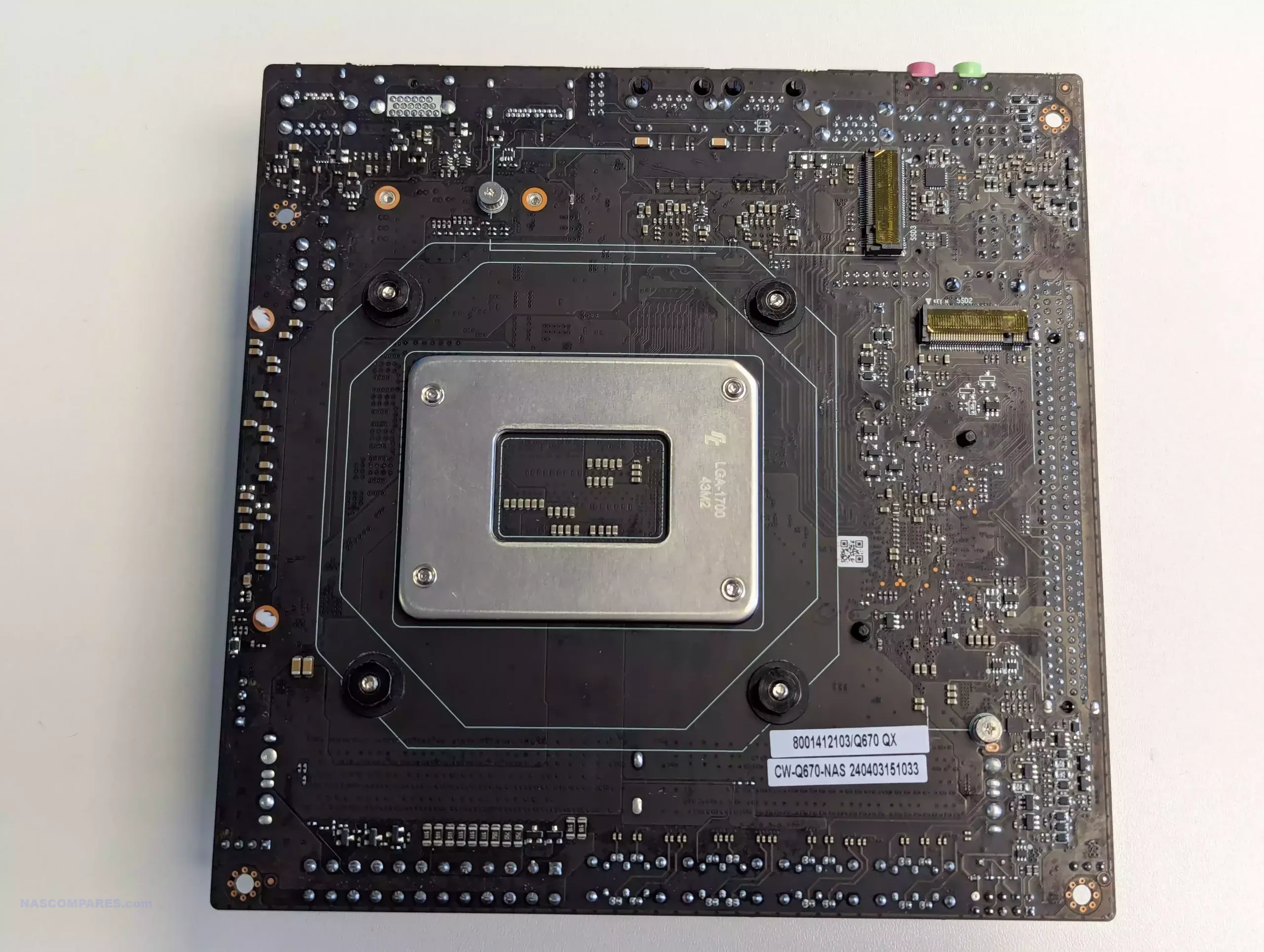
The Q670 features EIGHT native SATA 6Gb ports (no mini-SAS fan out requires or an m.2-to-SATA adapter) which really is a breath of fresh air, even if this NAS mobo wasn’t so feature rich already. Additionally, native SATA massively smooths any potential NAS OS BIOS conflicts in the event of managing large drive layouts.
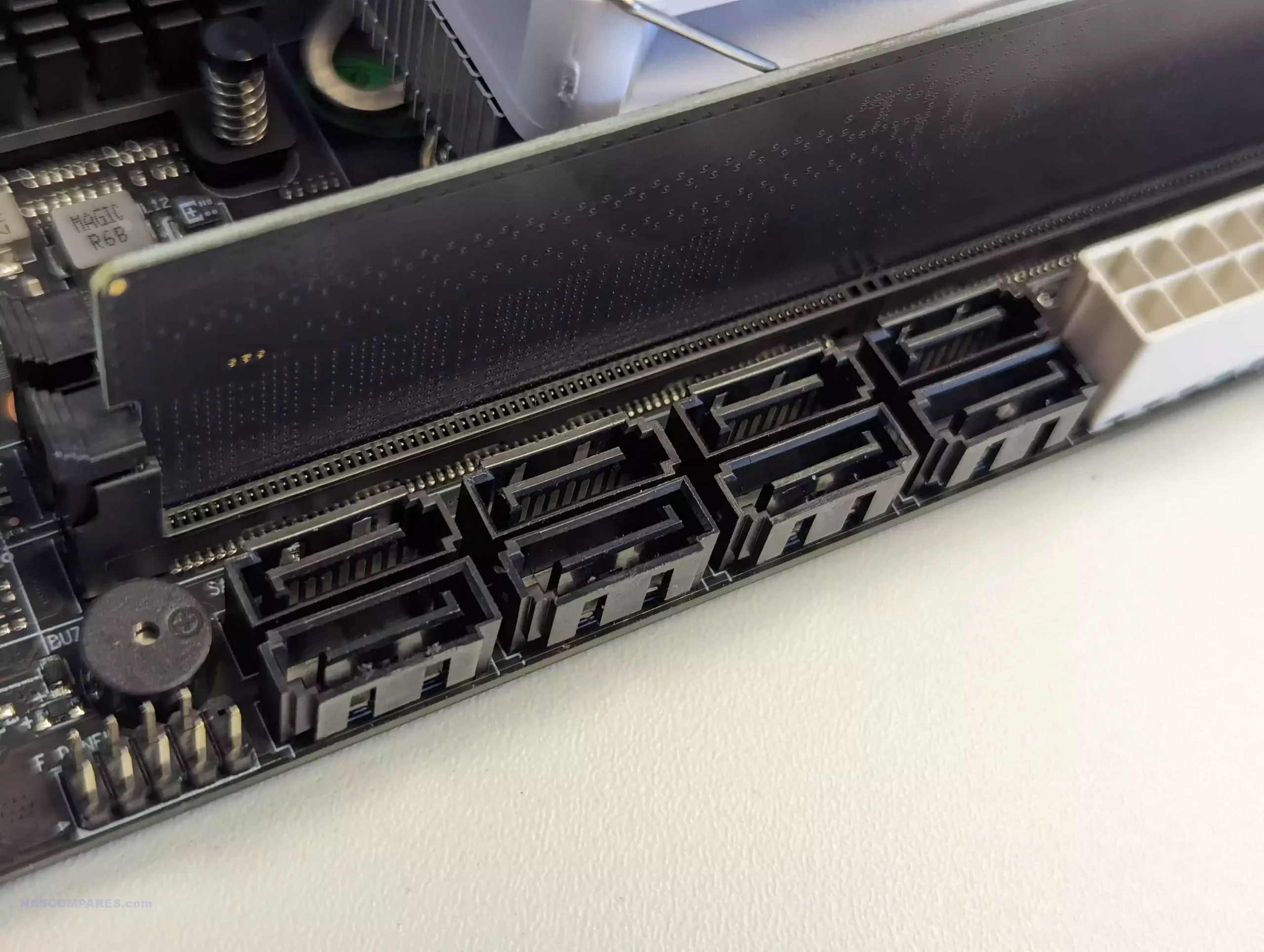
That said, this is definitely one of the earliest examples of this motherboard cramming in ALOT of hardware. The 8x SATA ports are directly next to the UDIMM Memory slots. The Q670 features two UDIMM memory slots, which one the face of it is GREAT! Rather than SODIMM (which most would expect from a mobno of this scale), UDIMM allows for larger memory capacity per module, as well as more common ECC modules available in UDIMM. Equally, newer generation CPUs support ALOT of memory, which this board is clearly ready to capitalize on! So what is the problem?
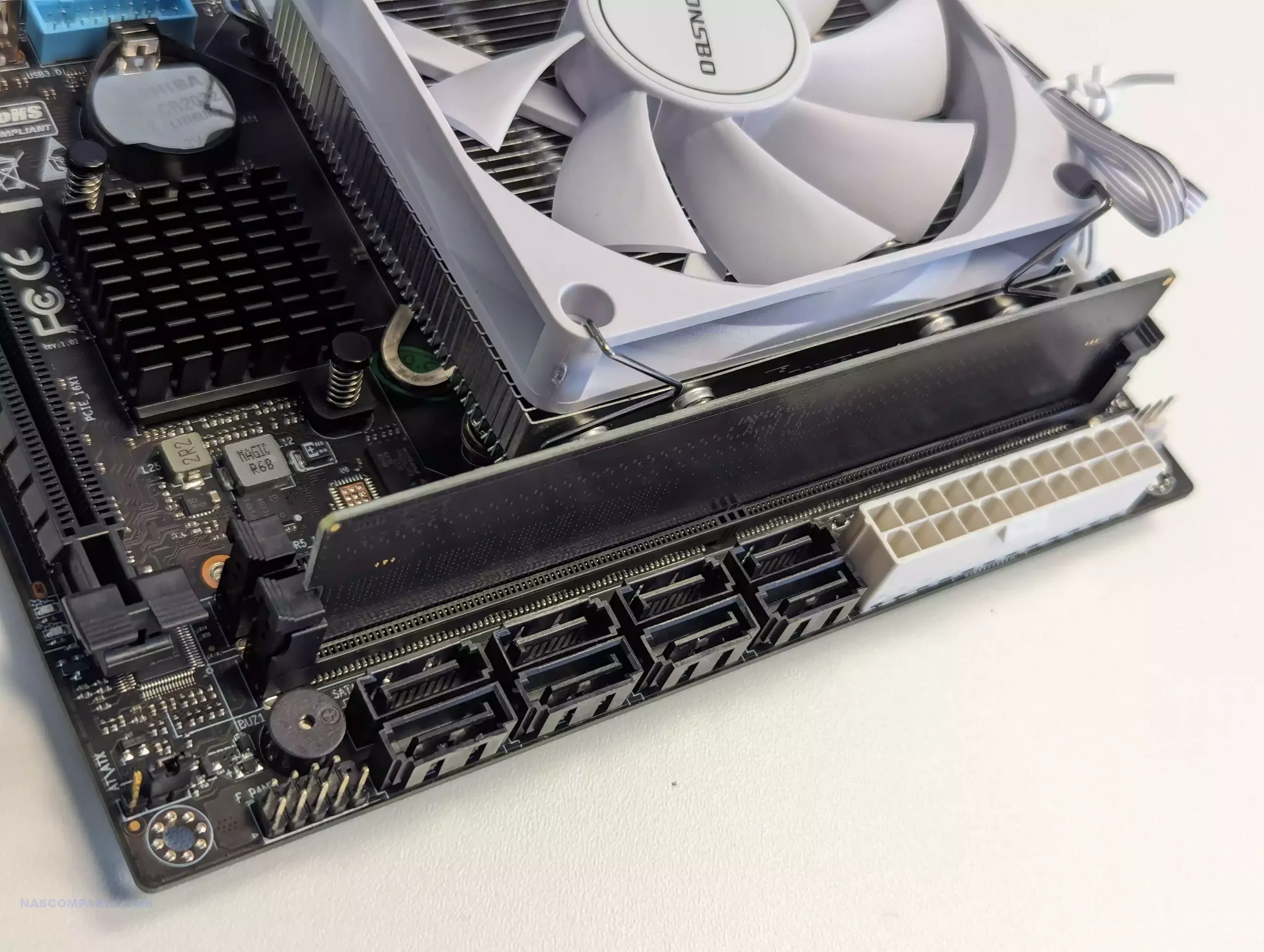
Well, those UDIMM slots are remarkably close to the CPU cooler and although there are plenty of good coolers in the market with a taller and slimmer profile, this can become problematic depending on the NAS case you are choosing to use.
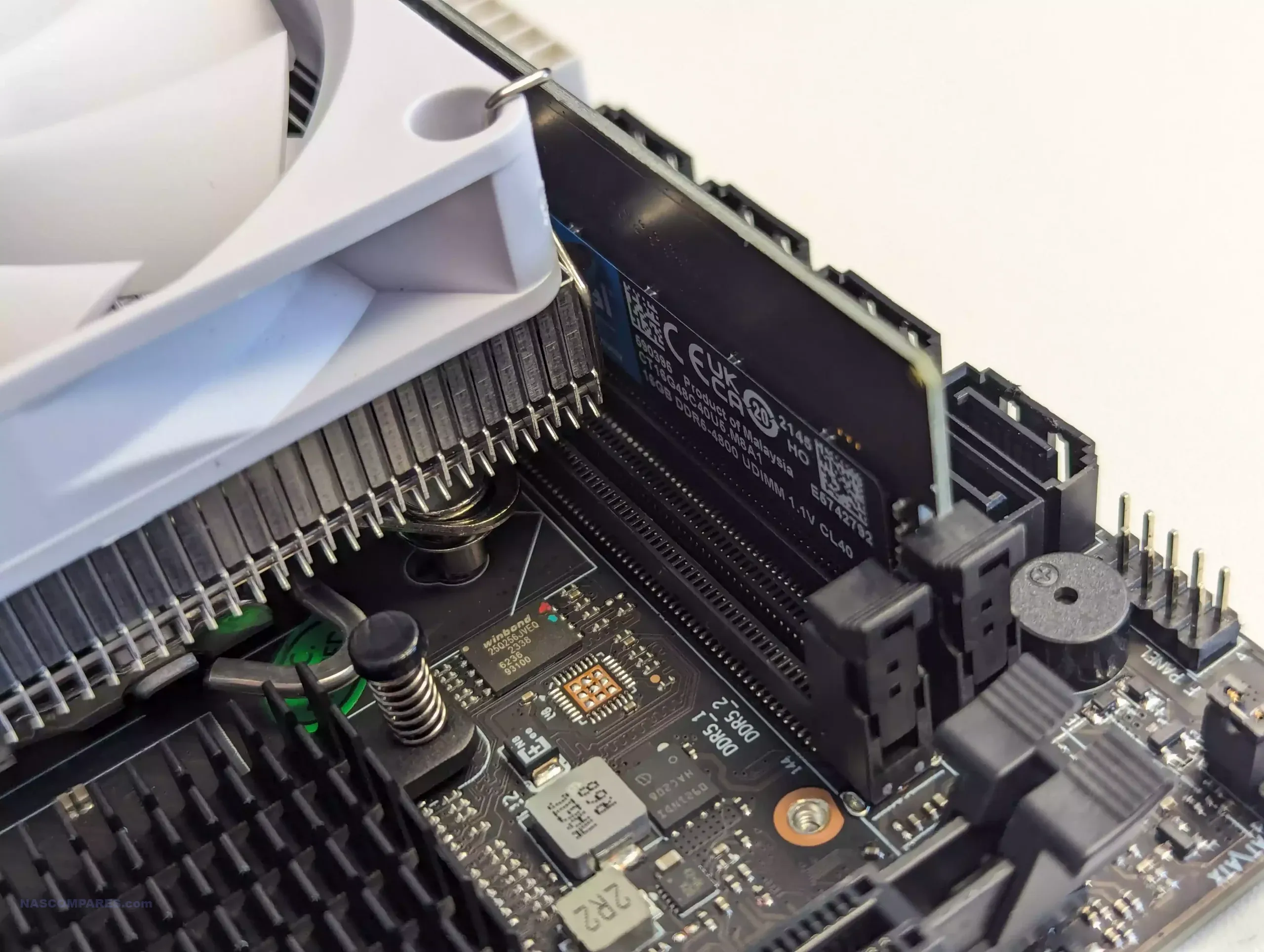
Alternatively (I can hear you thinking) you could just rotate the cooler? Well, on the other side of the cooler is your PCIe Gen 5×4 slot – and for those that know, PCIe Gen 5×4 gets HOT! So, it is always recommended that you use a fan assisted heatsink for a Gen 5 SSD – which will be directly in the path of your CPU cooler, if you rotate it.

Ok, what about facing it downwards? Well, that places you pretty squarely above your PCIe slot. The CWWK Q670 arrives with a very beefy PCIe Gen 5×16 card slot – but that’s just it – a single slot (one of those fun limits of M-ITX that is quite common, that I mentioned earlier). So you will likely be using this for a NIC upgrade (2 port 10g/25GbE card perhaps to get some serious saturation of those M.2 and/or 8xSATA) or adding a multi-port Gen 5×4 M.2 SSD card to start carving up that 5×16 slot into multiple SSDs via bifurcation? Hell, maybe even go extra wild and look at mid-high tier GFX cards.
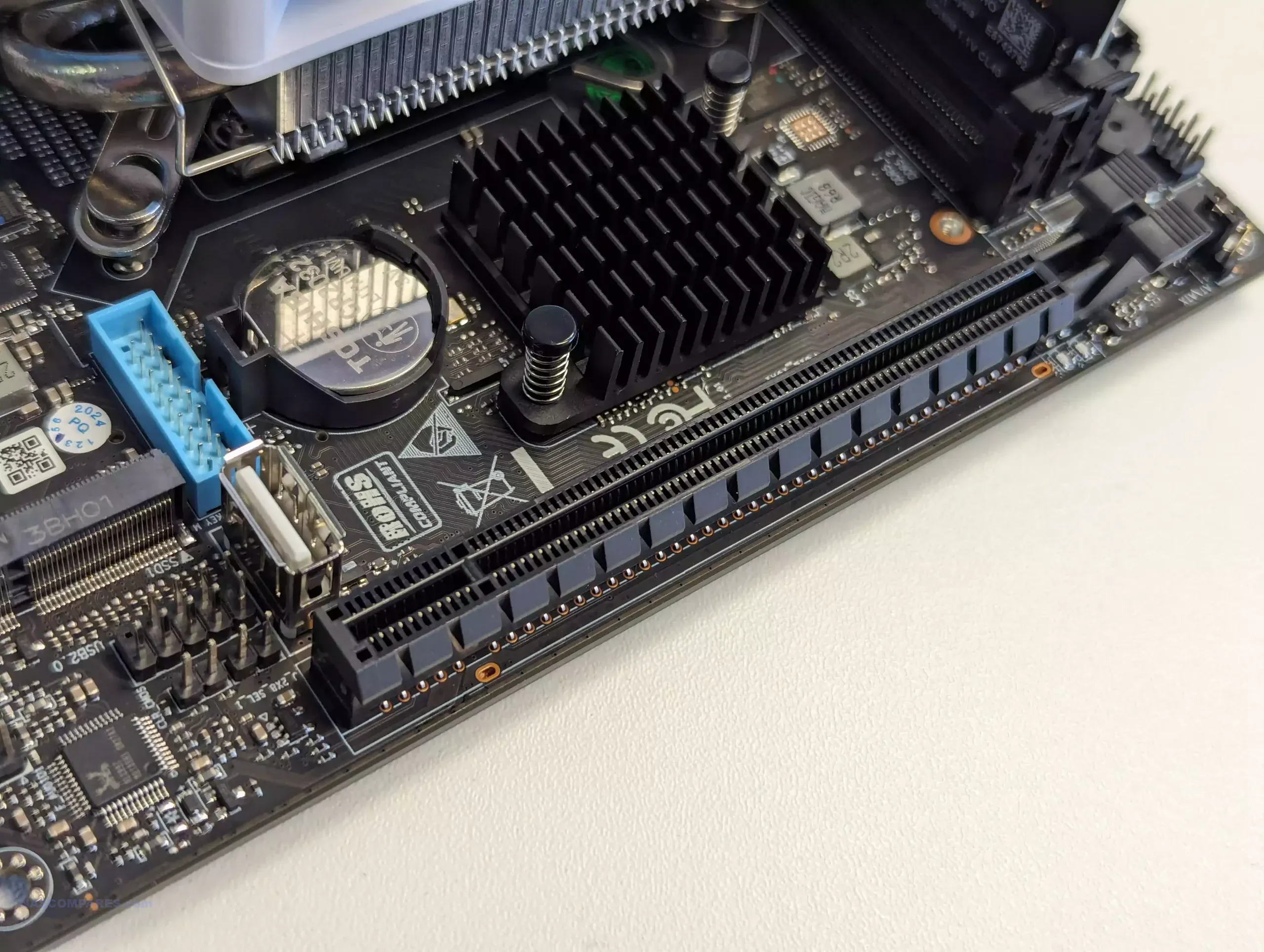
Regardless, you once again face quite alarming proximity with that CPU cooler if it faces in that direction! In 2 outta 3 (technically 4) of these placements of the cooler, you have nothing to worry about (even less still with a taller and narrower cooler), but that is still a lot of very high throughput components in close proximity that have quite obstructed airflow! Again, there are ways and means to mitigate with upright coolers, or even using watercooling and pipes – but that’s a lot to wrap around an M-ITX board when this scale of mobo is mostly there to reduce physical space on the server enclosure vs ATX.
Example on Aliexpresss HERE
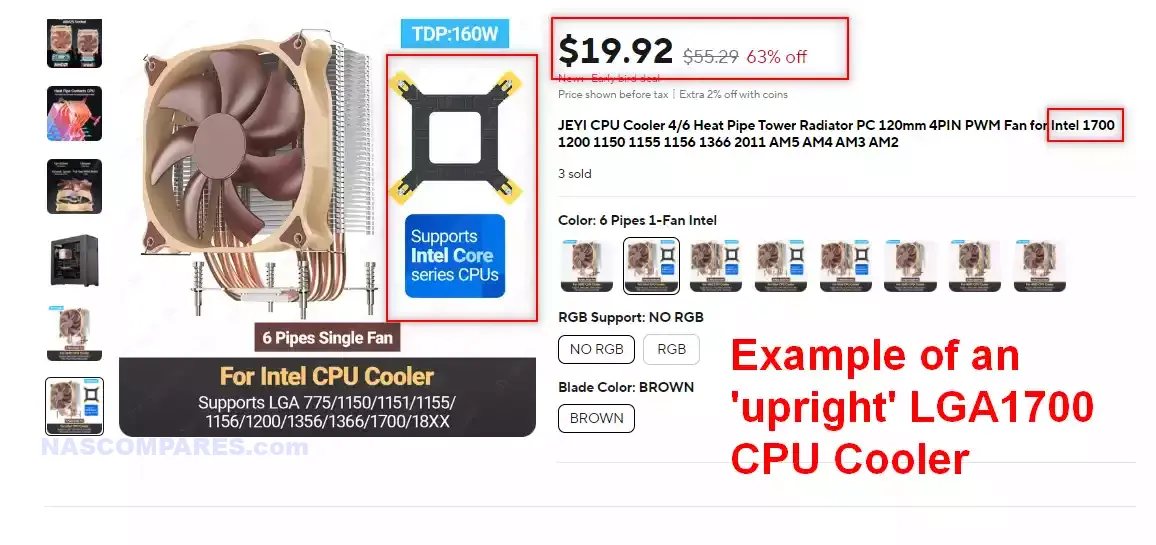 Returning to the M.2 Gen 5×4 slot, the Q670 might well be the first Gen5 M-ITX NAS Mobo that CWWK have ever released (and there are not a vast number of others out there from other brands either). Additionally, this slot supports up to the longer 22110 M.2 scale, which allows for larger capacity drive potential, better NAND distribution drives (i.e more, smaller capacity NAND cells on an M.2 PCB result in higher consistent performance vs fewer NAND cells of a larger capacity), plus longer 22110 SSDs can put the NAND all on one side of the PCB to better manage heat dissipation and physical space upon installation. This isn;t even factoring PLP SSDs either! This is a savvy move, as SSD makers are now hitting performance and temp walls when expanding Gen5 SSD technology and are perhaps instead favouring side-grading these drives to improve sustained performance and stability.
Returning to the M.2 Gen 5×4 slot, the Q670 might well be the first Gen5 M-ITX NAS Mobo that CWWK have ever released (and there are not a vast number of others out there from other brands either). Additionally, this slot supports up to the longer 22110 M.2 scale, which allows for larger capacity drive potential, better NAND distribution drives (i.e more, smaller capacity NAND cells on an M.2 PCB result in higher consistent performance vs fewer NAND cells of a larger capacity), plus longer 22110 SSDs can put the NAND all on one side of the PCB to better manage heat dissipation and physical space upon installation. This isn;t even factoring PLP SSDs either! This is a savvy move, as SSD makers are now hitting performance and temp walls when expanding Gen5 SSD technology and are perhaps instead favouring side-grading these drives to improve sustained performance and stability.
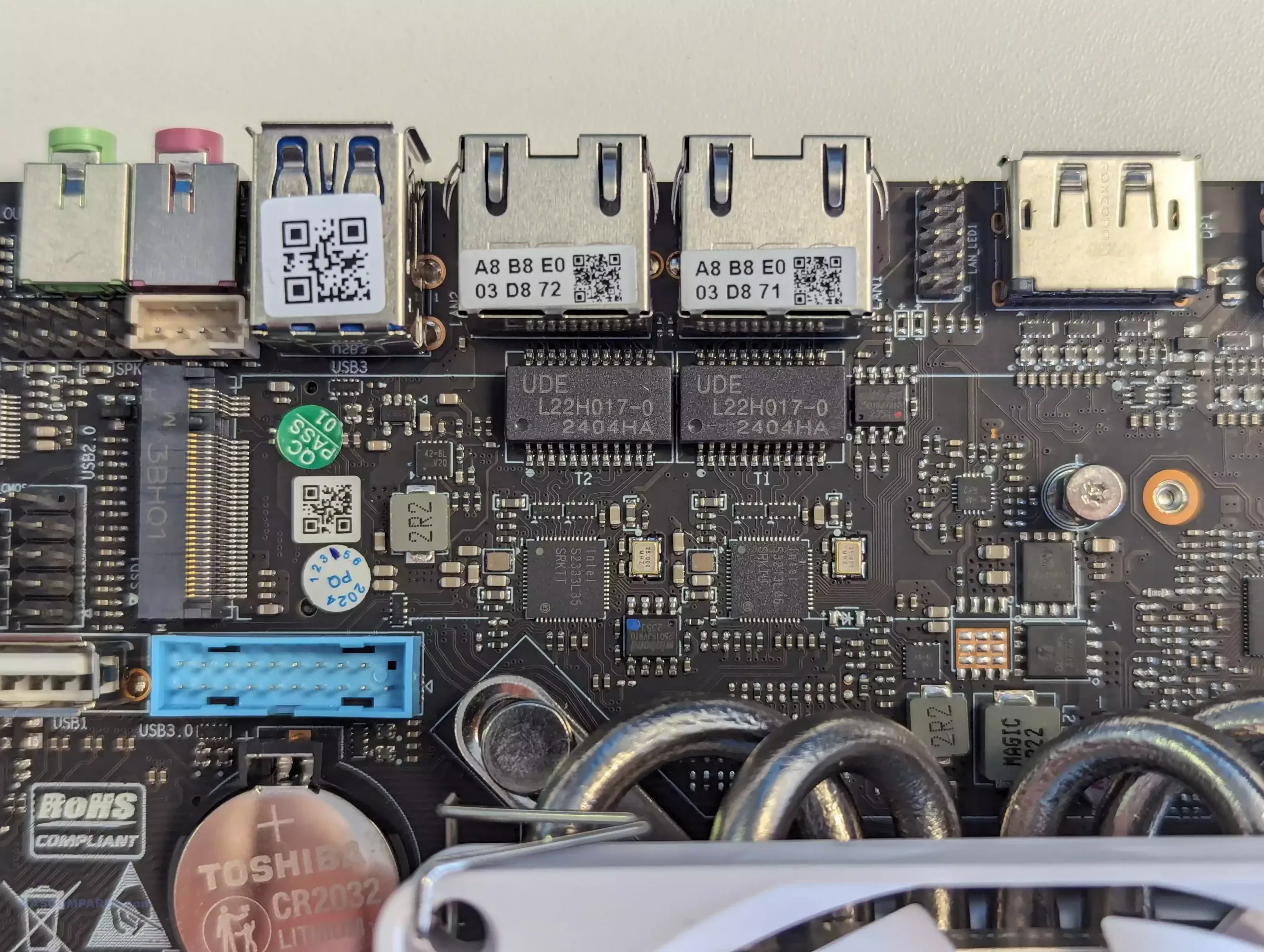
The rear M.2 NVMe slots are Gen 4×4, which makes a lot of sense, given just how far the architecture on this mobo has been stretched. As the mobo does not arrive with a CPU, the full extent to which an end user can tinker with the architecture and how much lane/speed can be afforded to these slots is up for debate. Just because the board CAN hit Gen 5 and 4 respectively on these M.2. does not mean you are going to get it without the right CPU choice!
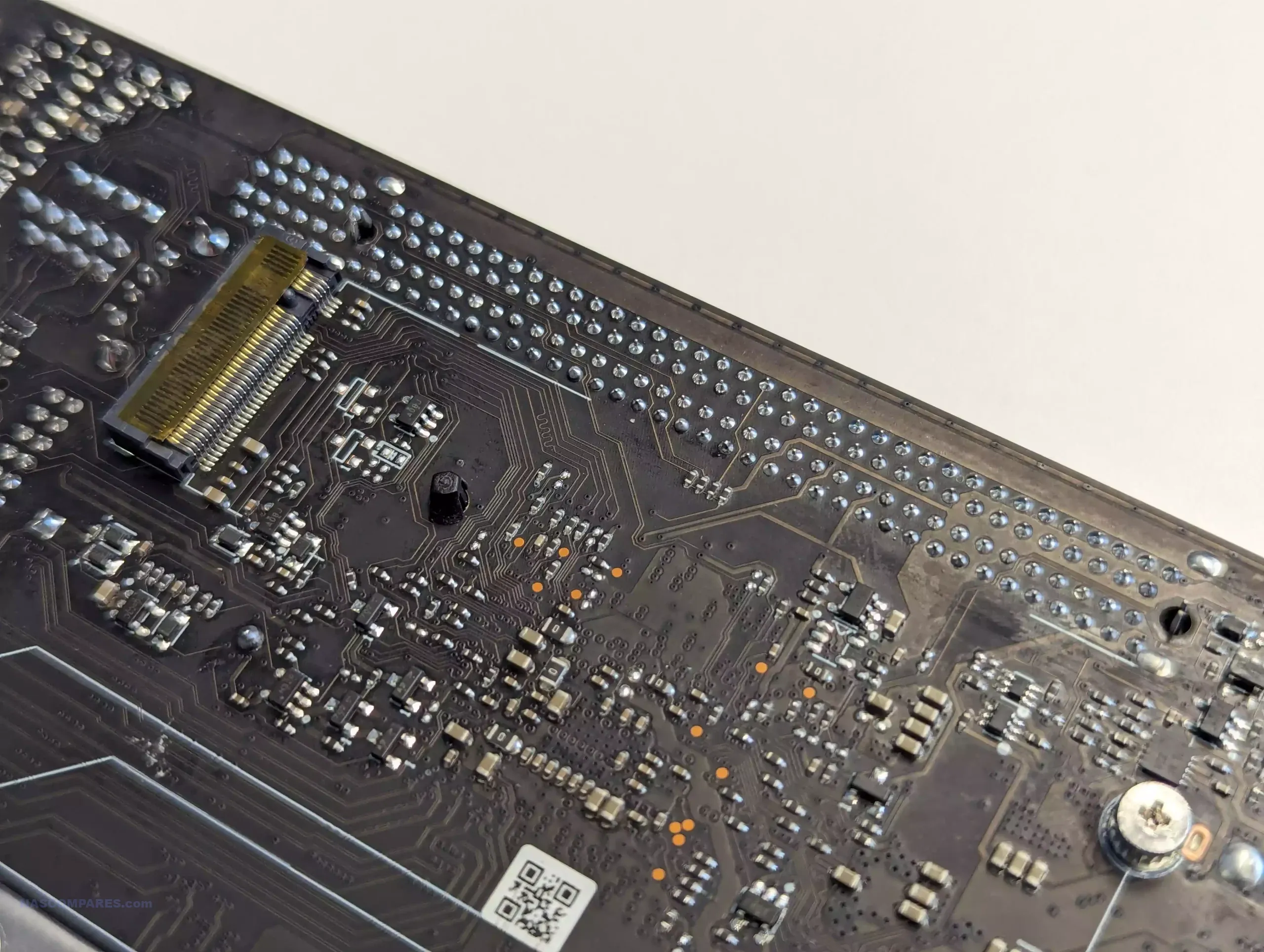
Both the Gen 4×4 slots are 2280 in length (only the Gen 5 is 22110) which, in a way, is a bit of a shame, as these two slots have a whole lot of surface area to play with compared with the comparatively cramped surface when the Gen5 slot lives. Nevertheless, it’s great that this board is ready to go for 8 SATA HDD/SSDs and 3 M.2 NVMes (and that is even before you start considering the PCIe Upgrade slot. That said, the BIOS on this board is (on the plus side) incredibly flexible in it’s configuration, but also (bad side) tremendously intimidating in it’s range of choices, with lane distribution depending on your CPU choice being quite hard going!
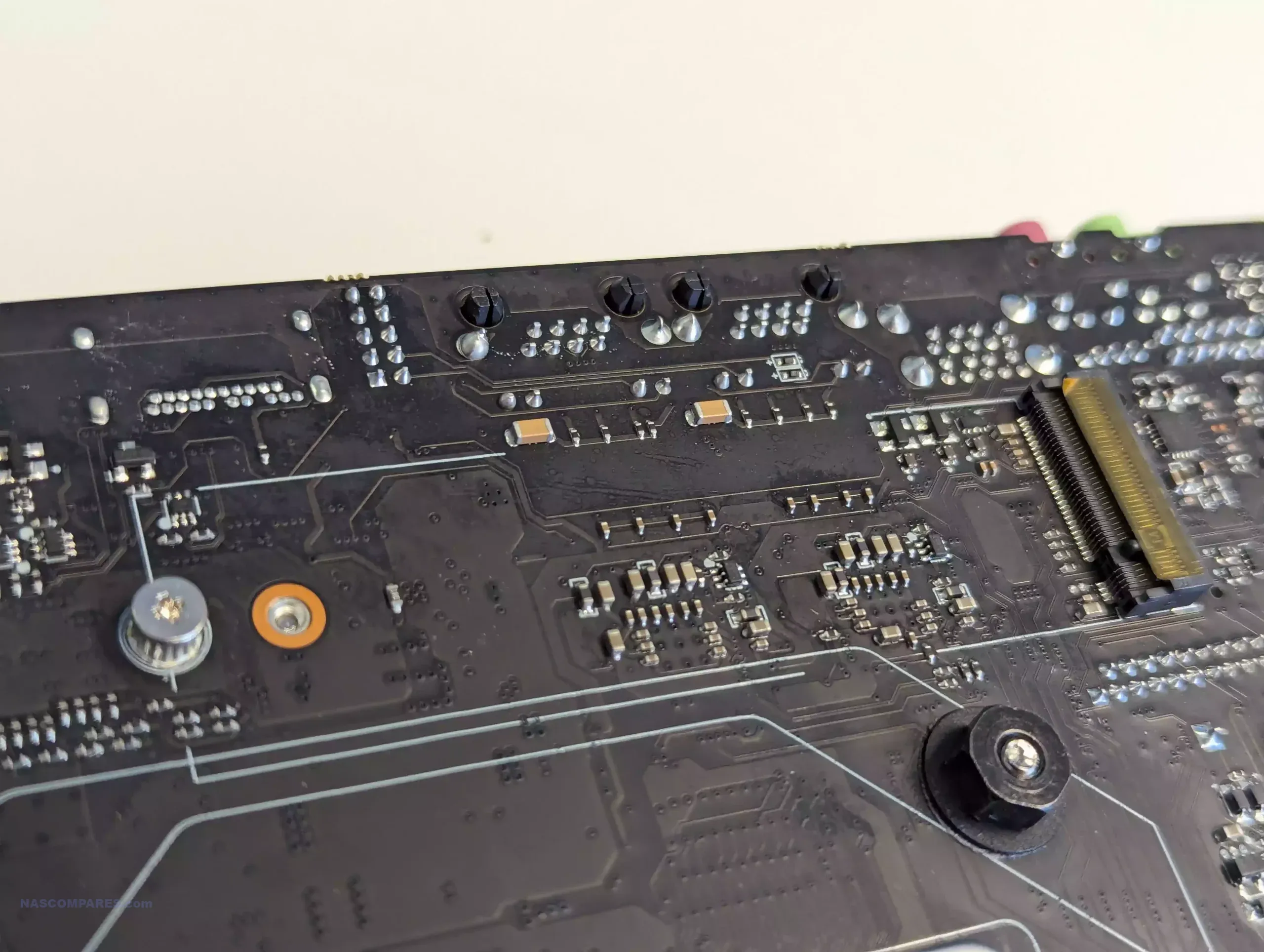
This opens the door towards how many/much of those M.2 are going to be usable with the PCIe slot in use. With a higher, more modern and more capable processor, there’s a good deal to share around, otherwise you end up making touch lane speed choices!
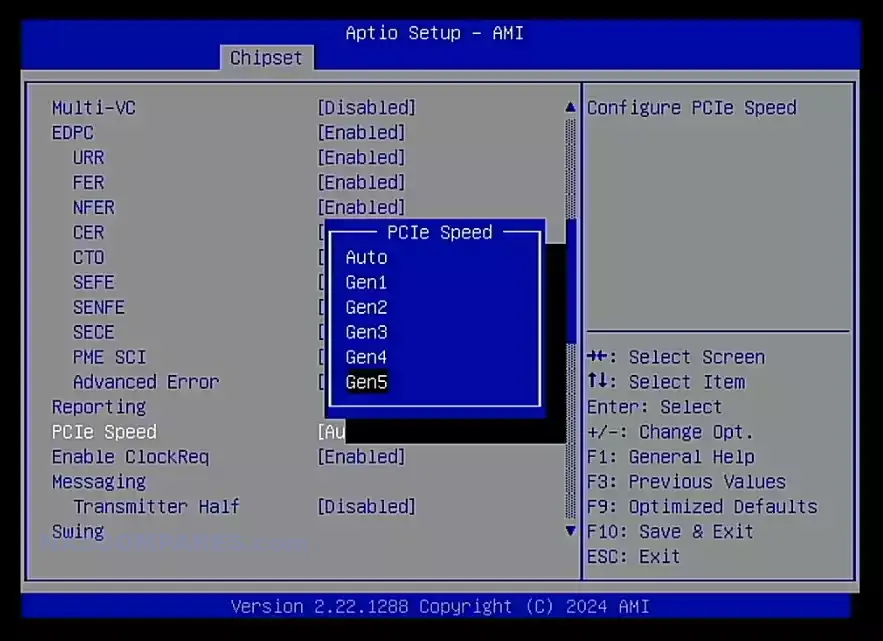
The rang of ports and connections on the board are actually a fraction ‘safe’, with the USB connectivity and an additional network control feature being the only area with a slight bit of difference from the bulk of CWWK boards.
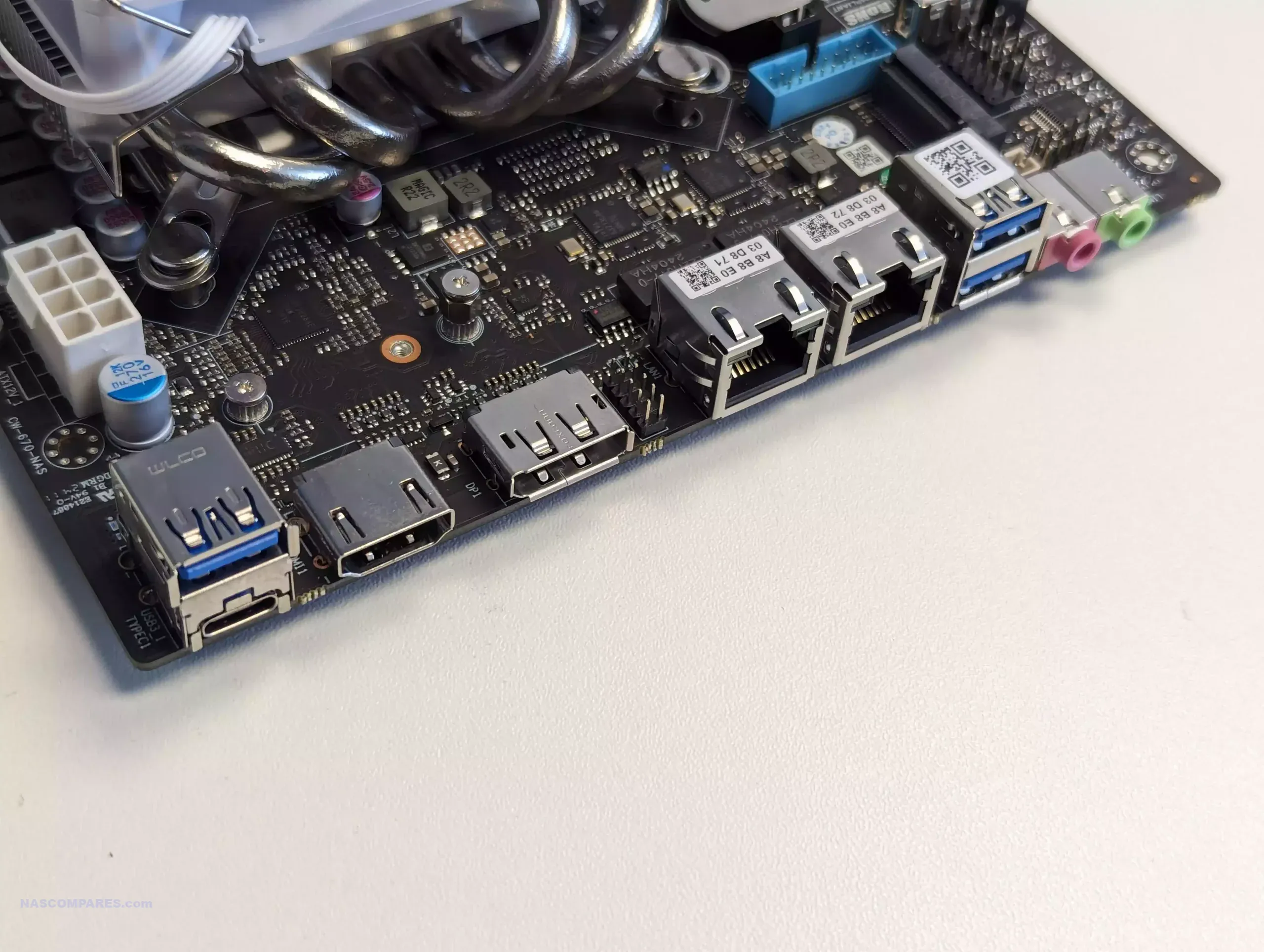
There is a fairly pedestrian USB-A 3.2 port, but there IS a 20Gb/s USB-C port. This is listed as just “3.2 20Gb/s”, so its a little unclear on whether this is USB 3.2 Gen 2×2 or a USB 4 port that that has had its bandwidth halved.
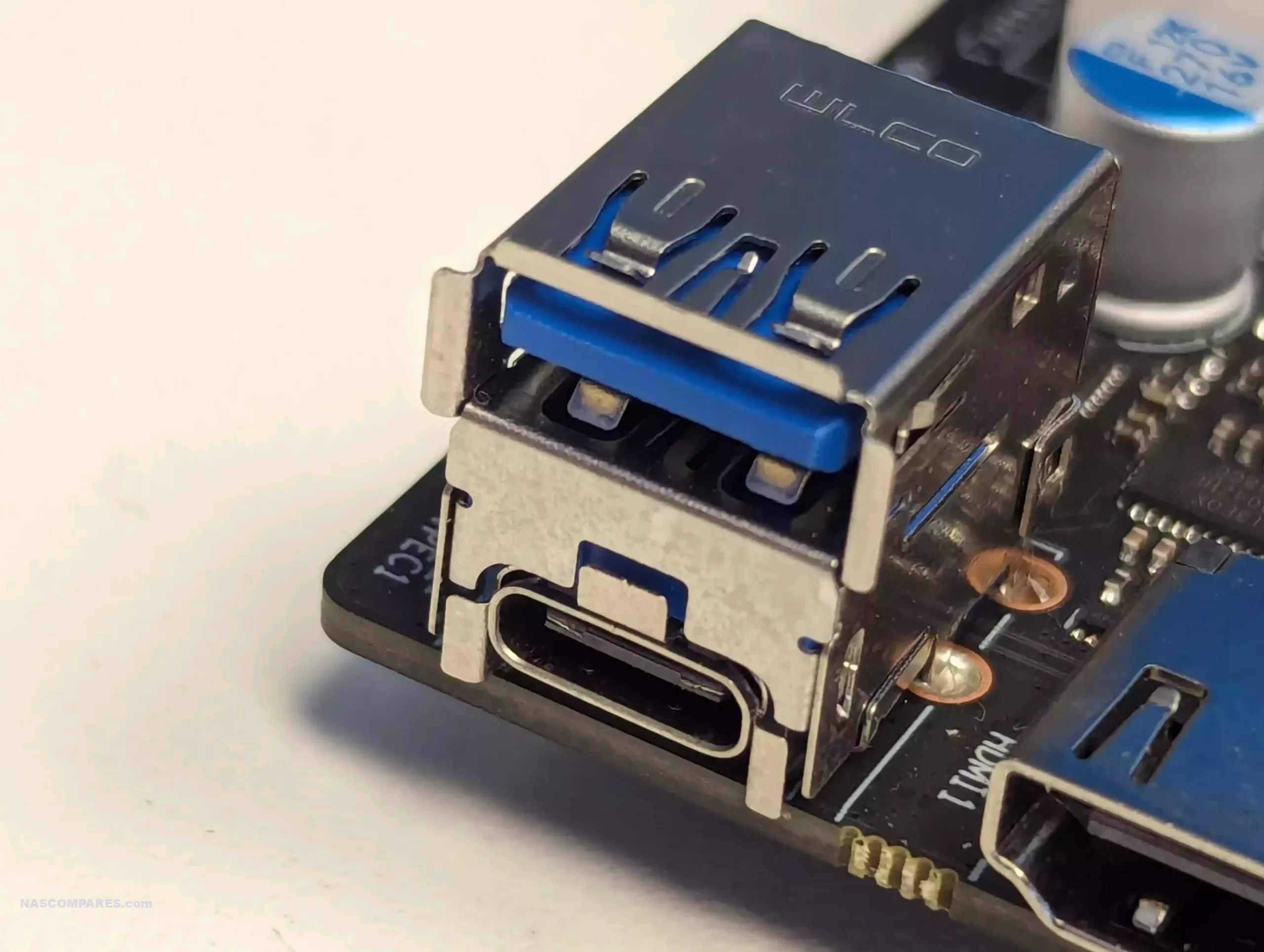
There are visual outputs of course (an HDMI 2.0 and a DisplayPort 1.4) which can output at 4K 60FPS, but the extent to which these can be used is going to be heavily dependant on your NAS OS of choice again.
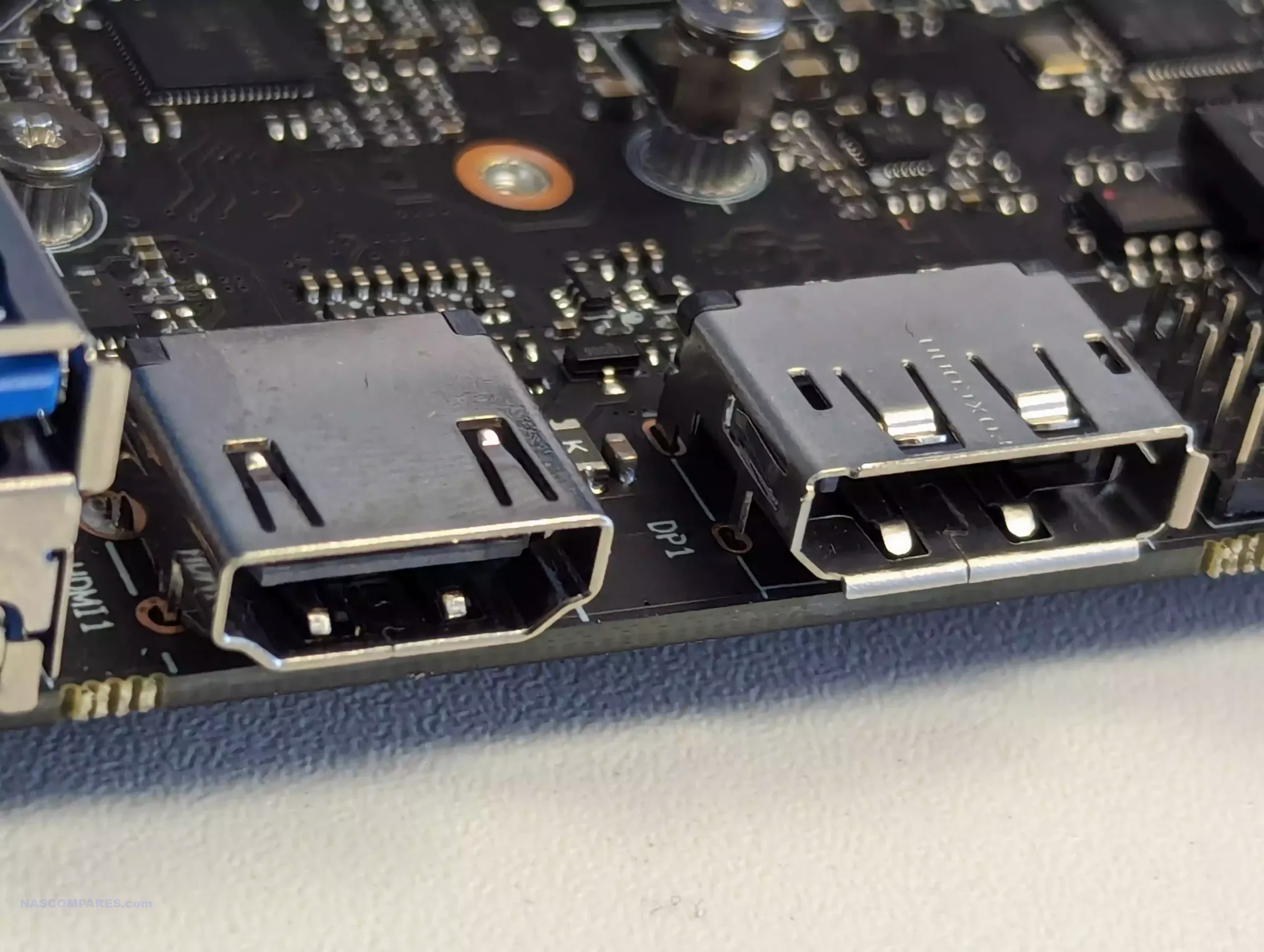
The USB Type A connectivity is 5Gb(s) Gen 2 and there are two ports available, a bit ‘so-so’. But better to have lots of USB 5G ports than 1-2 10G ports (I know this is not an opinion often shared!)
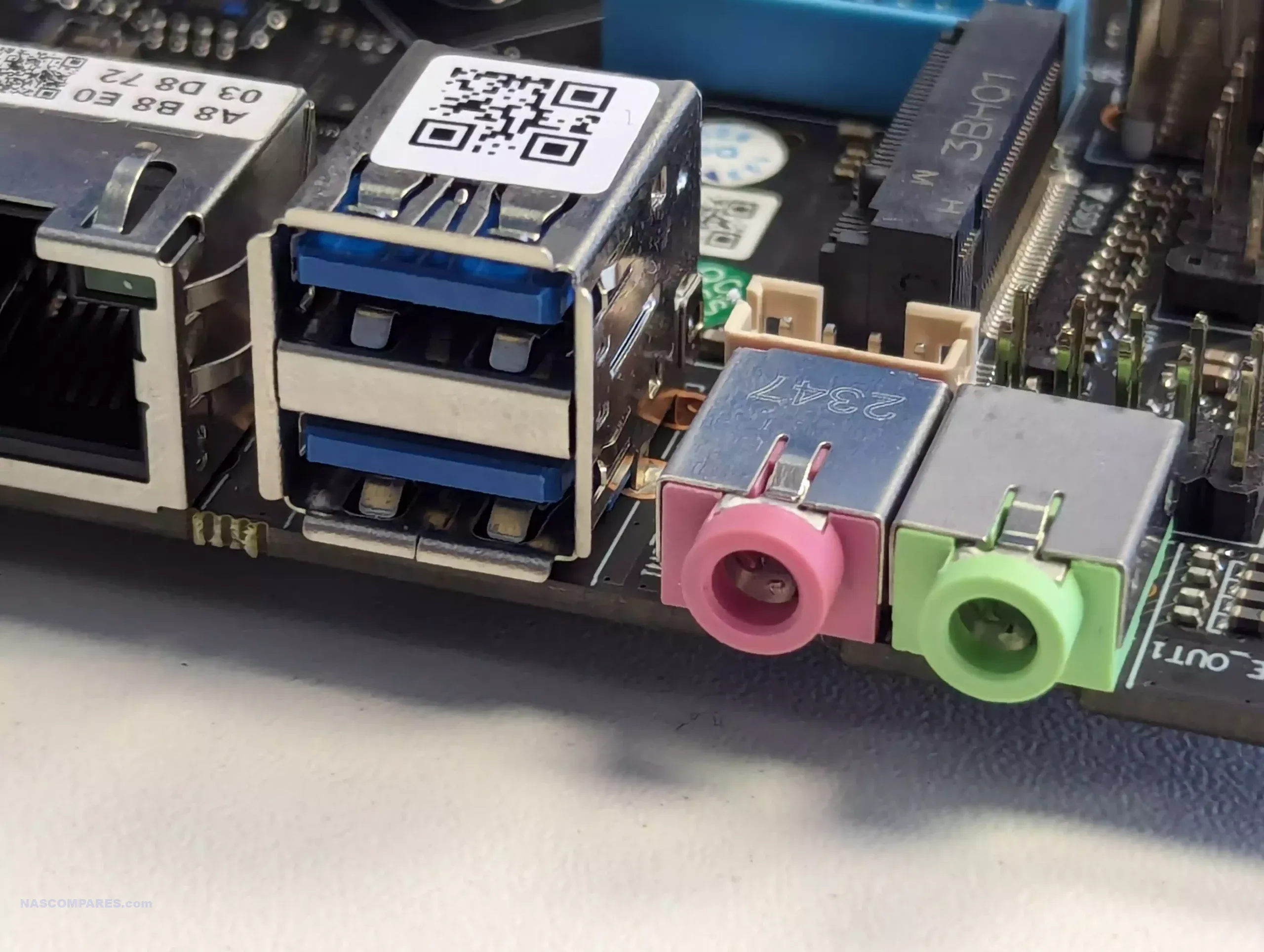
But I do like the internal USB 2.0 port, as that is perfect for an UnRAID setup on this motherboard – and now that ZFS pools are fully stable and supported in UnRAID, it makes the 8+3 storage slot CWWK Q670 exceedingly desirable.
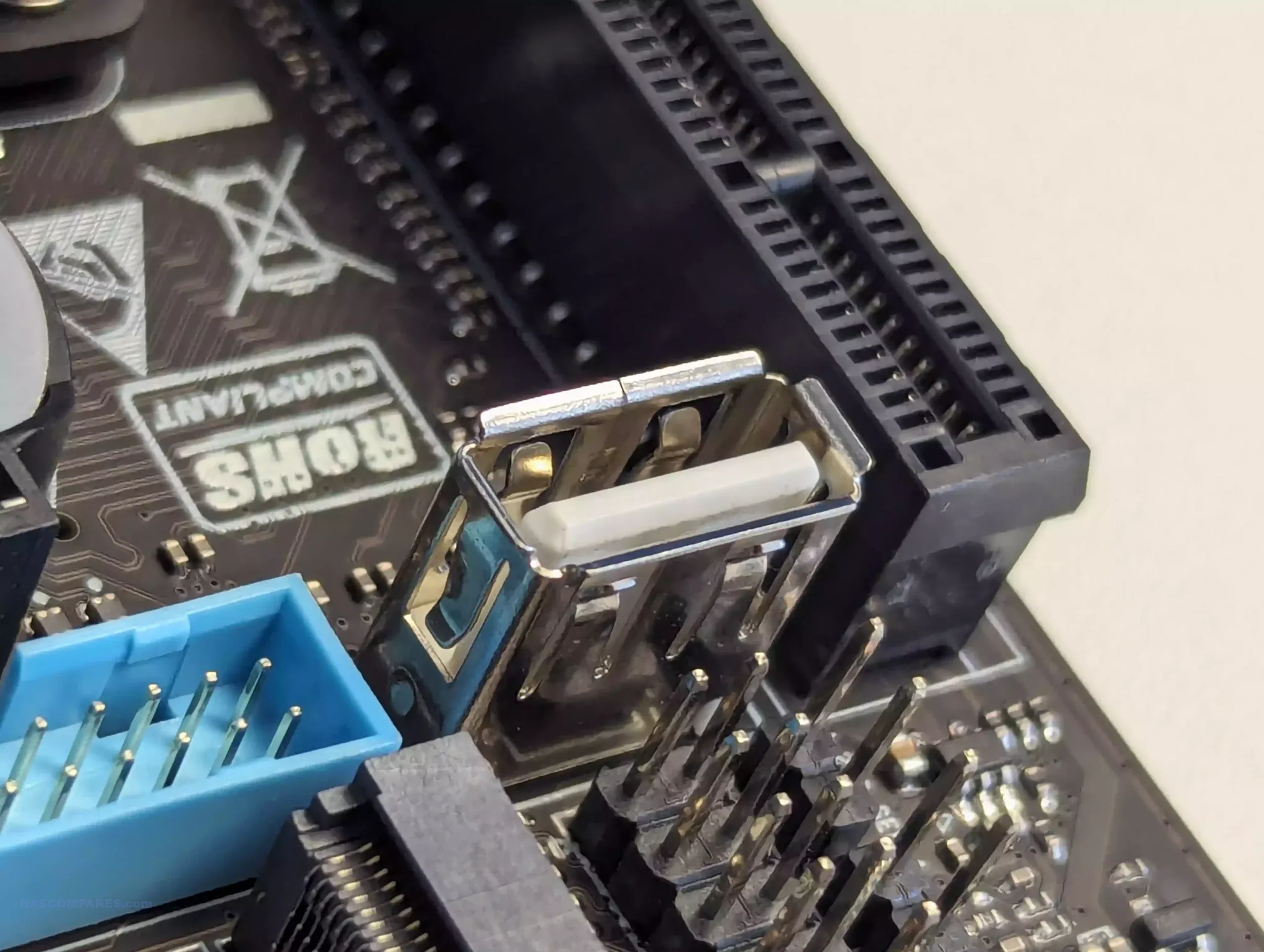
The network ports are both 2.5GbE, which is going to be something of a bottle neck externally (especially when you factor in that even a medium-sized mechanical Pro/Ent HDD can hit speeds of 250-282MB/s), but that is where that PCIe slot will add network scalability, and don;t overlook the appeal of combo cards (M.2 + 10G cards) from brands like QNAP that work on this board (I tested the first gen QM2 Combo card).
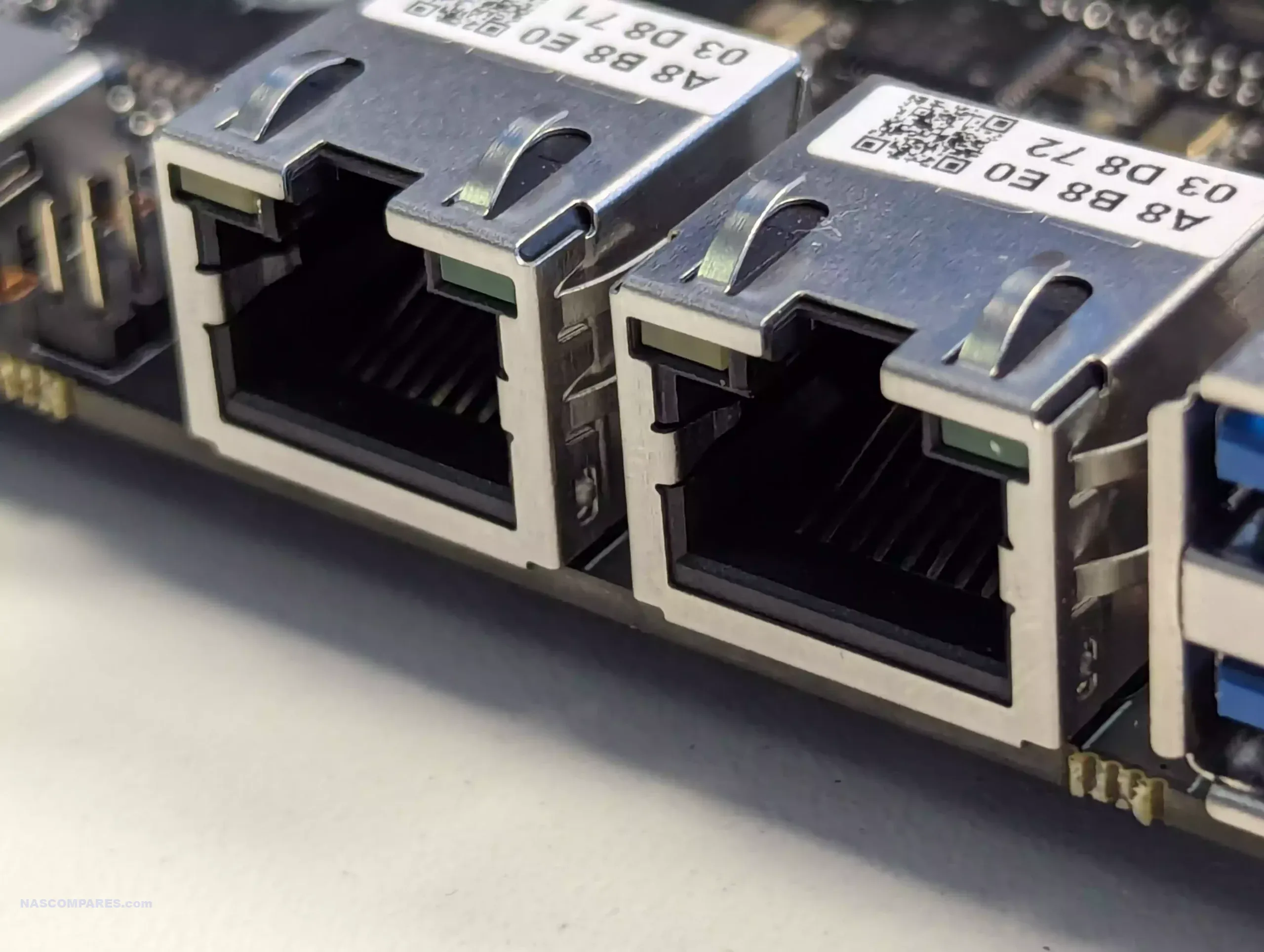
However, interestingly the Q670 also arrives with the support of Intel vPro which, for most users, is going to serve as the ideal gateway to manage their system backend configuration remotely – I am talking BIOS level. In practice, that means that having to awkwardly KVM into a system that is typically deployed without any accessories is avoidable. It requires a little setup and using the vPro interface requires further setup, but ultimately this is a nice extra that is a lot rarer in DiY NAS boards than you might expect.
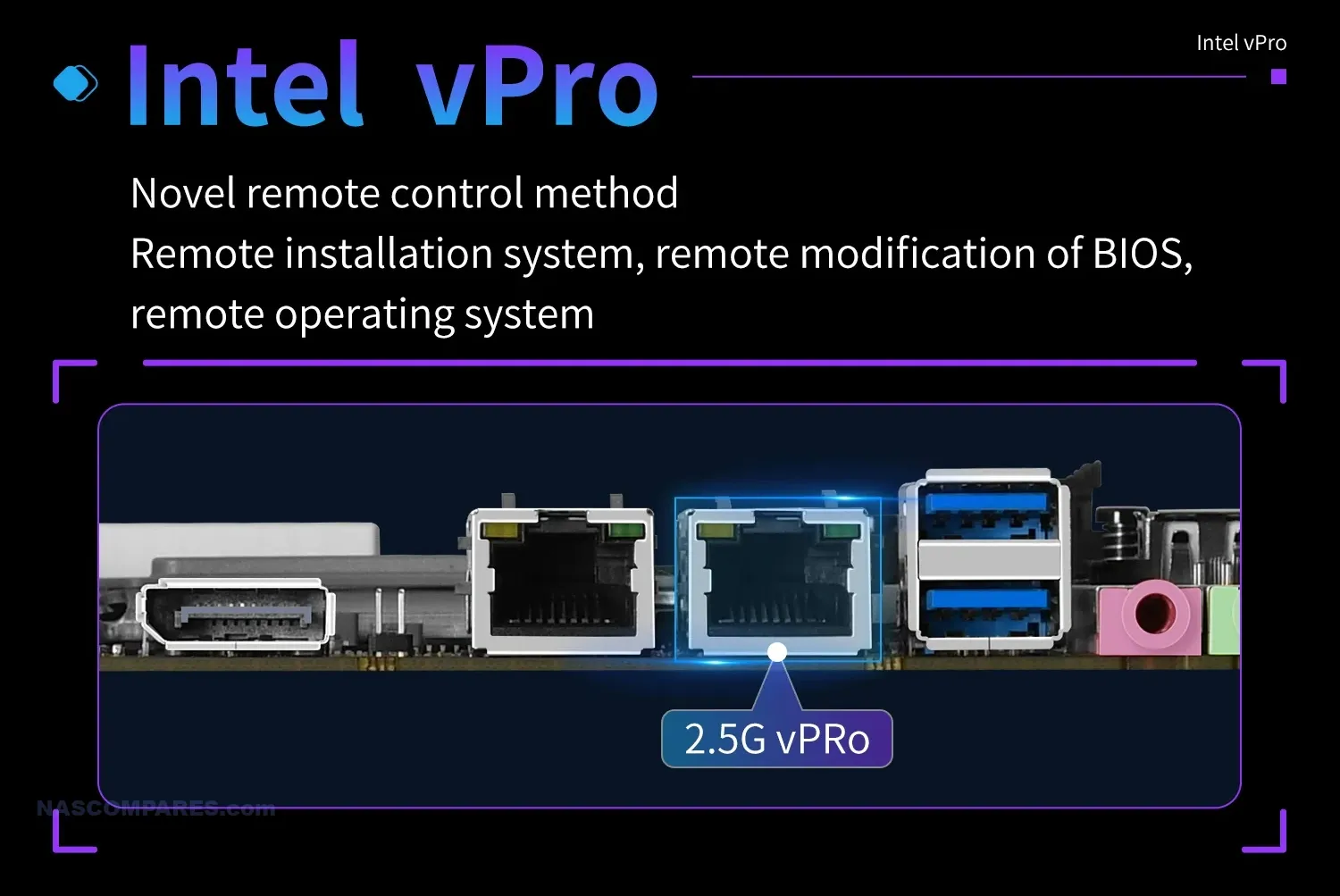
Overall, this might be the best balance of hardware scalability and storage scalability on a reduced physical scale that I have EVER seen, not just in DiY. Plus, arriving at the $200 price tag all adds up to a NAS board that provides tremendous hardware customization on a larger NAS system, without braking the bank + allows you to put that money you saved towards a beefy CPU and some excess memory! Let’s discuss that hardware configuration internally and what a fairly average and affordable CPU can get out of it?
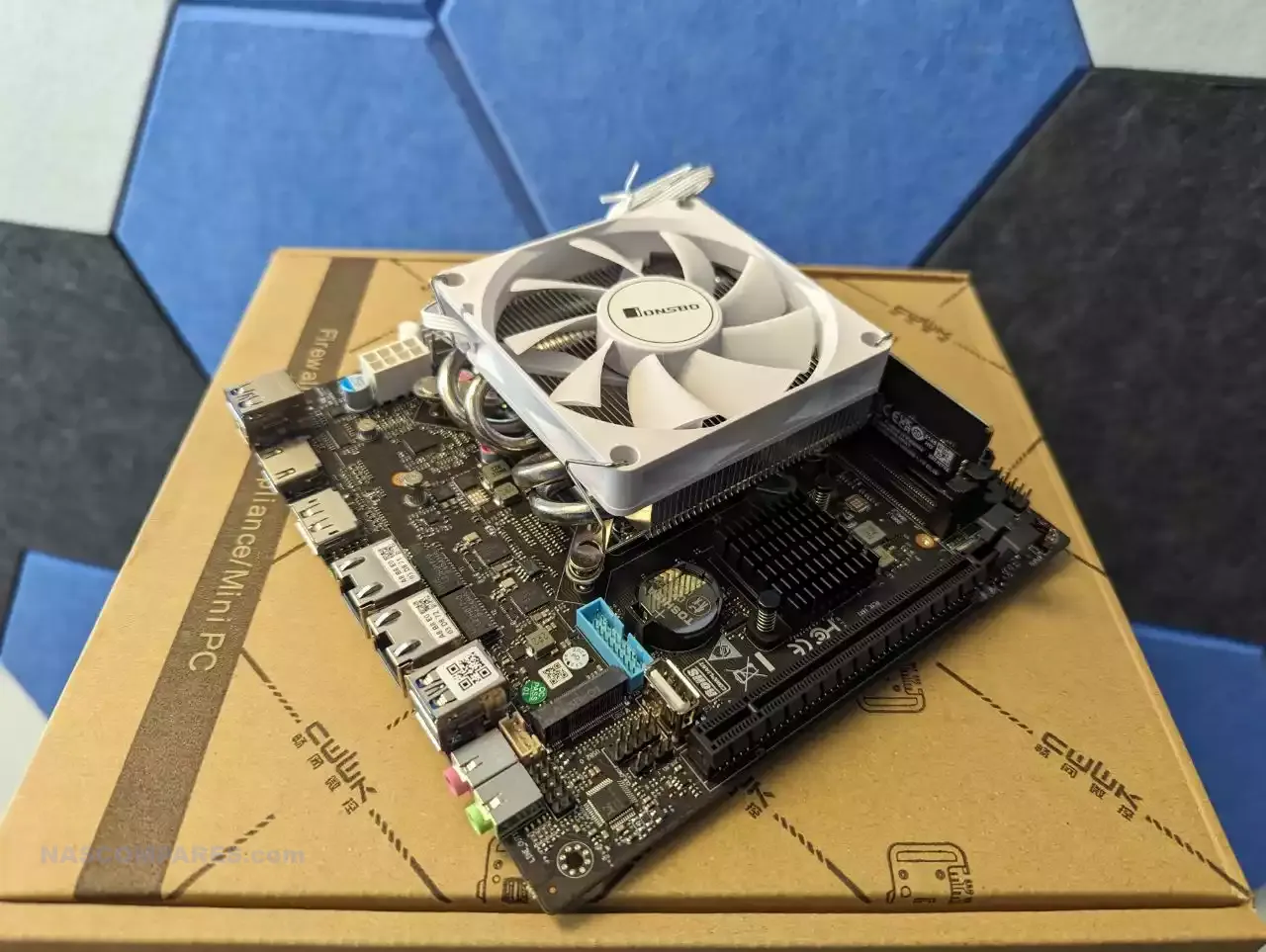
CWWK Q670 Gen 5 NAS Board Review – Performance and Tests
Performing any tests on a NAS motherboard that is not available with an integrated CPU was always going to be tricky, as it means the results are always going to be fantastically relative to that specific configuration and represent one of hundreds or even thousands of configurations – and the CWWK Q670 is no exception. To get some base level understanding of the board on it’s own, here is the hardware spec it arrives with:
| Feature/Service | Details |
|---|---|
| vPro Function | Requires i5-1X500 or above processor. F series does not support it and requires core graphics. |
| Power Efficiency | Recommended T processors such as 13500T for power efficiency and long-term use |
| Supported Memory Speed | DDR5 supports 5600MHz by default (12th gen processors only support 4800MHz) |
| USB Features | Built-in set of USB 3.0 and USB 2.0 pin sockets for panel connection |
| Display Support | HDMI + DP dual display output supports 4K @ 60Hz |
| Network Management | Intel i226-LM 2.5G RJ45 supports Intel vPro remote management function |
| Operating System Compatibility | Supports Microsoft Windows 10/11 64-bit, Compatible with Linux (EFI mode only) |
| Memory Compatibility | Dual-channel desktop U-DIMM DDR5 slot supports 5600MHz backward compatibility |
| Miscellaneous Software | Supports U disk encryption, system booting |
I went ahead and installed an Intel 6-Core / 12 Thread 12th Gen i5 Core and 16GB 4800Mhz non-ECC DDR5 Memory. Straight out the gate, just using three M.2 NVMes on the system (full benchmarking, Gen 4 and Gen 5) the system hit around 45W utilization. Had I connected eight SATA HDDs, I can imagine this would have been almost doubled! However, there were not 8 drives in our test area available at the time of this review.
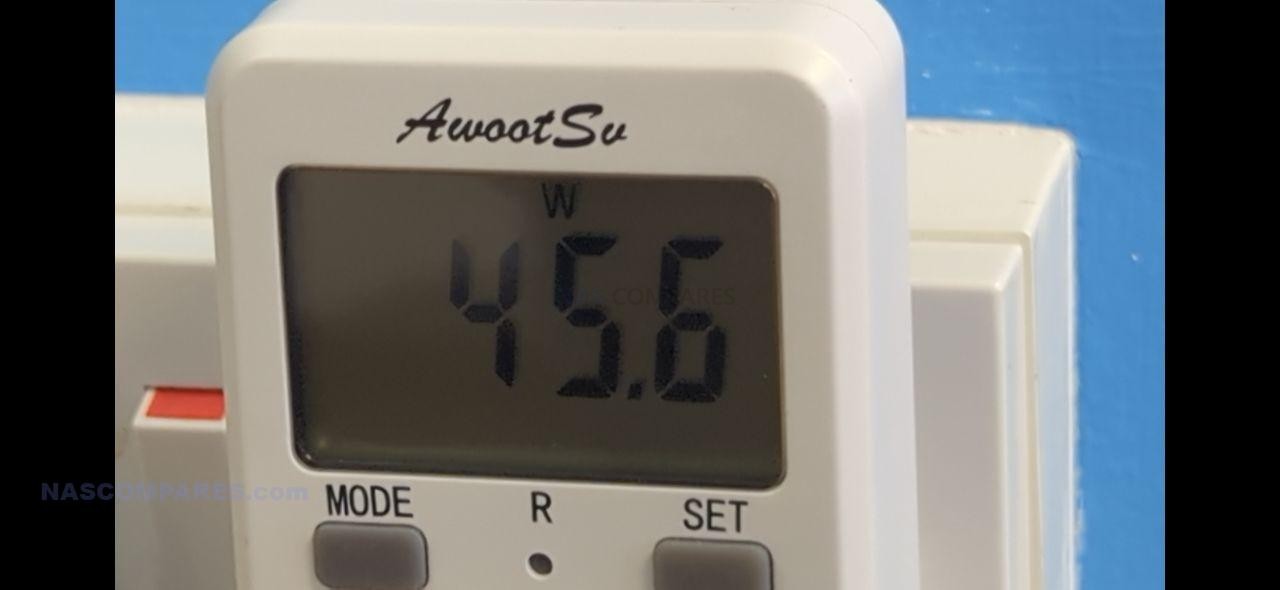
As mentioned earlier, the BIOS that is available on this board is pretty deep, even by ‘bare mobo’ standards. Also, adjusting the PCIe Gen goes up to Gen5 all over the shop!

I went ahead and ran UnRAID on the system (thank you, small internal USB Port!) and a;; the SATA/M.2 slots were visible and good to go!
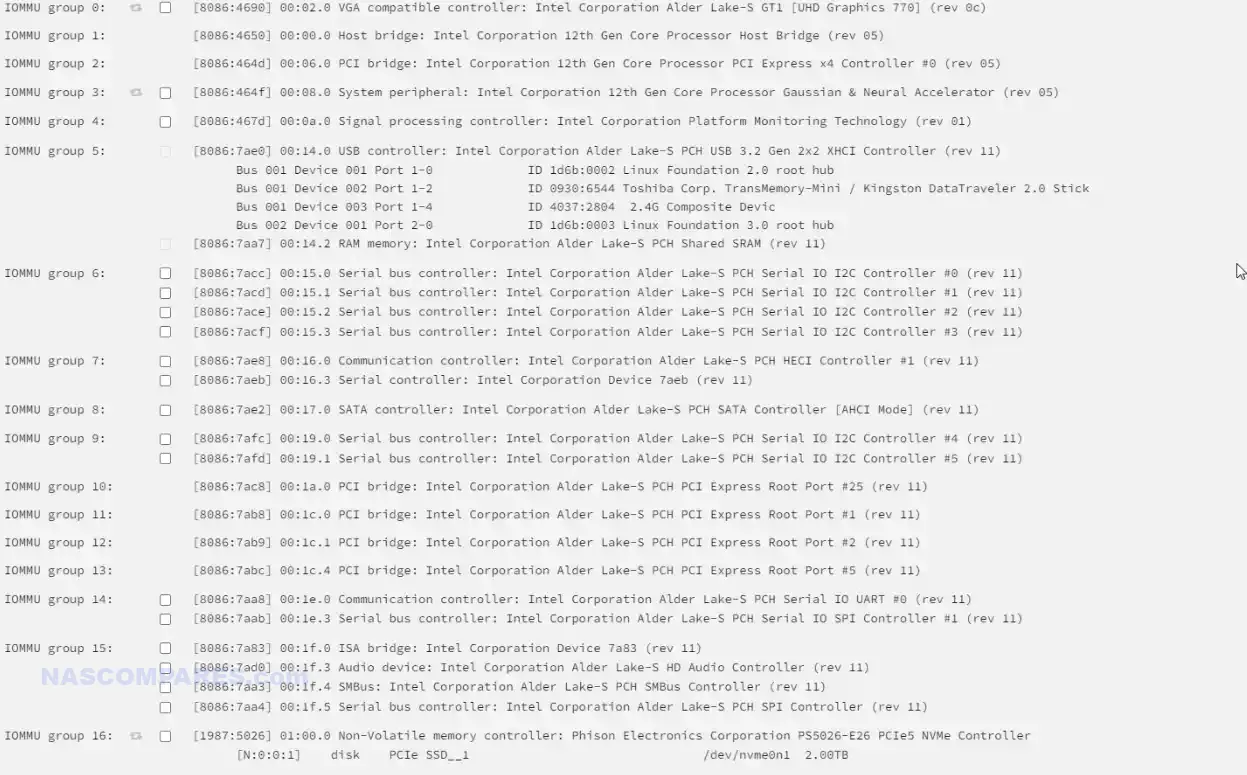
The layout of the system in it’s default configuration (using the i5 I installed) was reasonable, but the speeds on the M.2 slots was definitely a little ‘funky’, especially when you factor in that I installed Gen 4 Kingston KC3000s and a Gen 5 Phison E26 M.2 in their respectively supported slots.
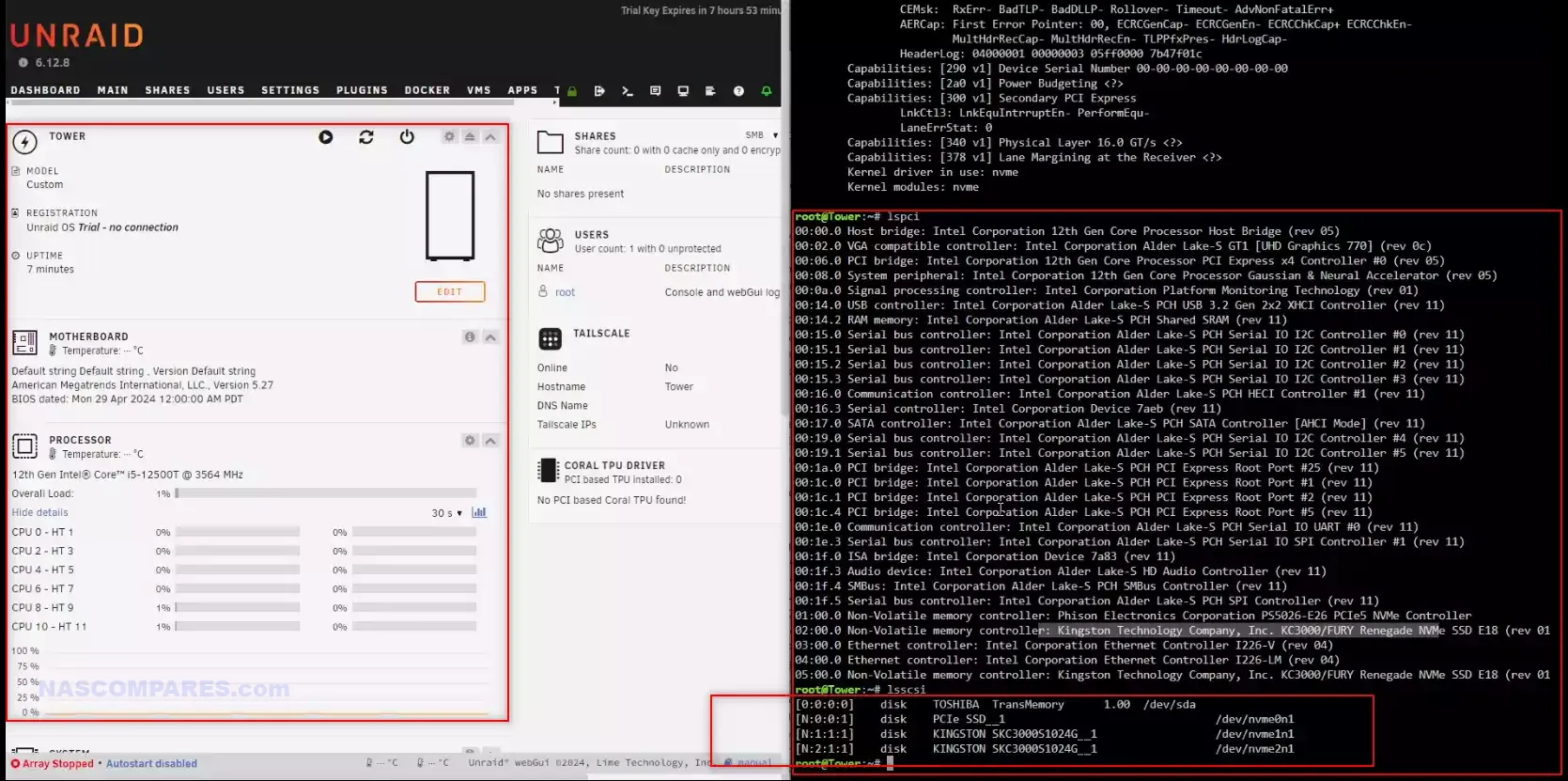
The first disappointment is that, unless I used up a scaled-up processor and spent some time playing with the bios, the Gen 5×4 slot was downgraded to Gen 4×4. Gen 4 is still good, but the major appeal of this Mobo for some users is going to be the fact its Gen 5 SSD ready. What about the Gen 4 slots?

Well, good news and bad news there. The first Gen 4 M.2 slot was defaulted at Gen 4×4 WITHOUT any downgrade. Great stuff, right? Well…
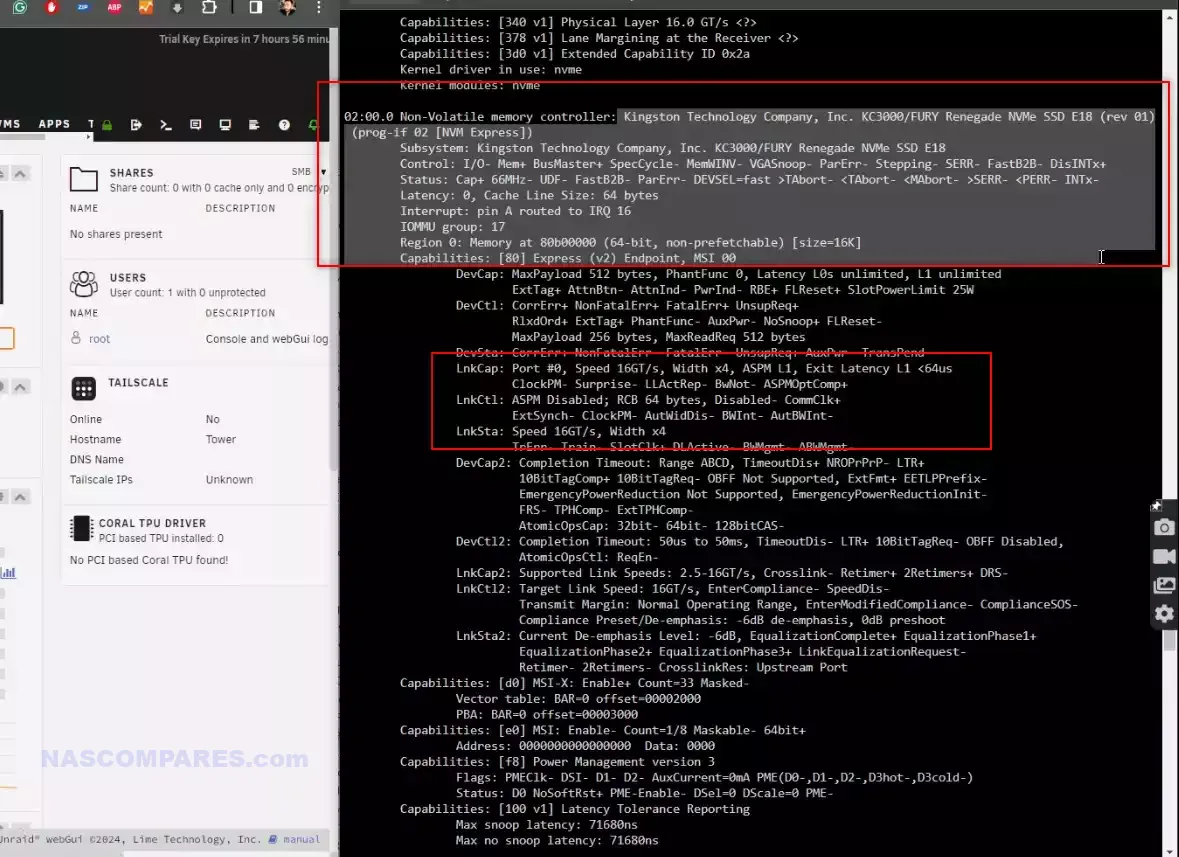
The 2nd Gen 4 slot had been downgraded to Gen 3×4! Remember, this is how the the system has default laid things out with the i5 12th Gen processor I choose to use. I am sure there is wiggle room for this and as mentioned several times, this configuration is one of literally thousand of possibilities, but I raise this to demonstrate that this board needs some hands on work by the user when its installed to get the most out if it for the end user’s needs.
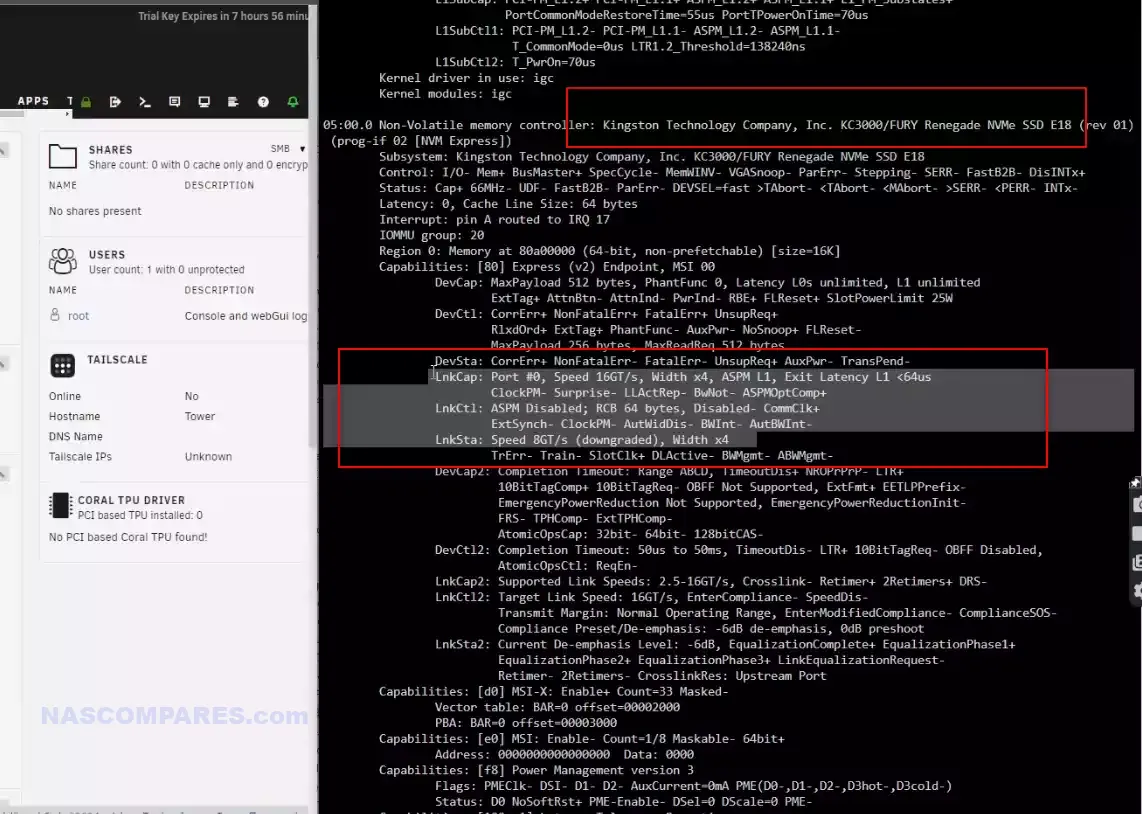
Looking at performance, within the gen and speed that this motherboard defaulted to, these are all reasonable. Eg the Gen 5×4 slot (that SHOULD hit a potential 10-12GB with the right drive) was hitting a respective 6GB/s, as it was downgraded to 4×4.
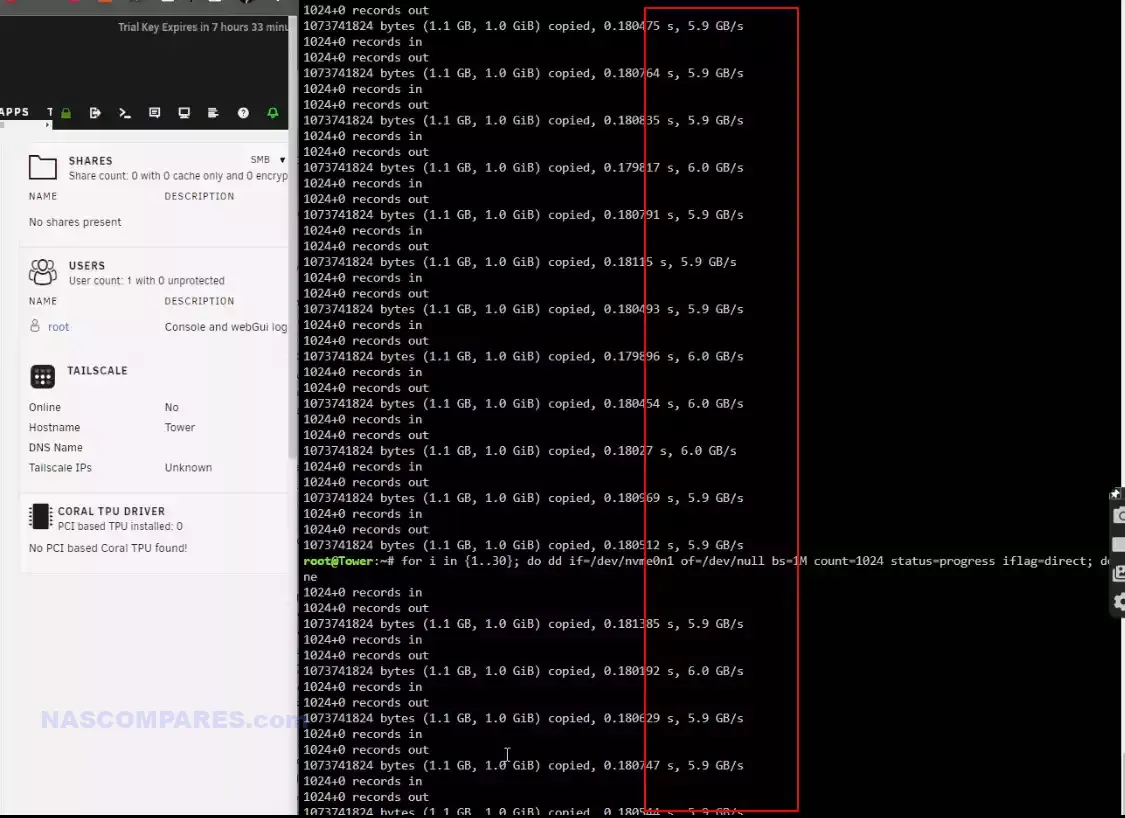
Likewise, the Gen 4×4 m.2 slot that had not been downgraded hit 5.9-6GB/s. Not the reported 7GB that Kingston says this drive will be capable of hitting of course, but those benchmarks are based on much more powerful setups and tools than these comparatively primitive tests.
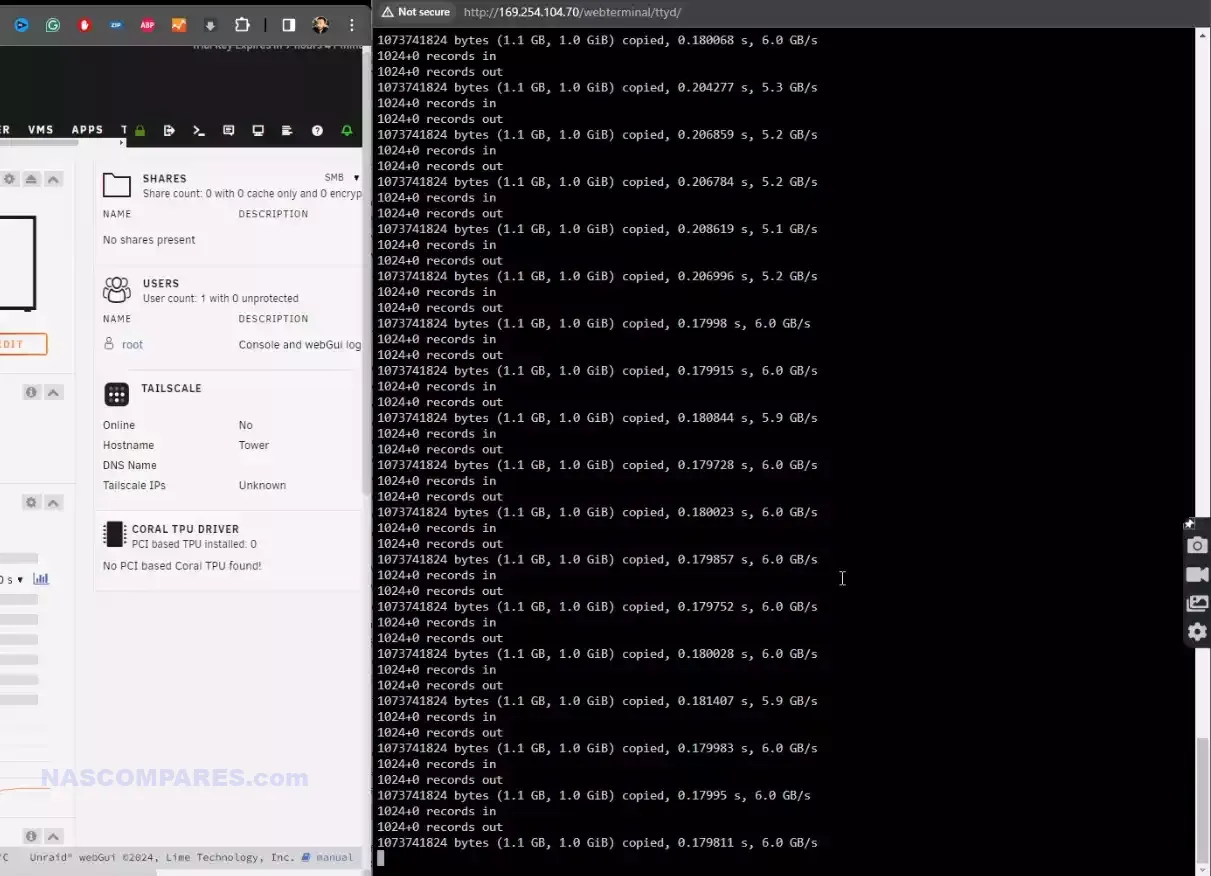
And then there was the Gen4 slot that had been downgraded to 3×4. Thanks to it still being ‘x4’, the Gen 4 drive, even with it’s forced downward auto-negotiation, was still hitting respectable 2.9-3.0GBs numbers.
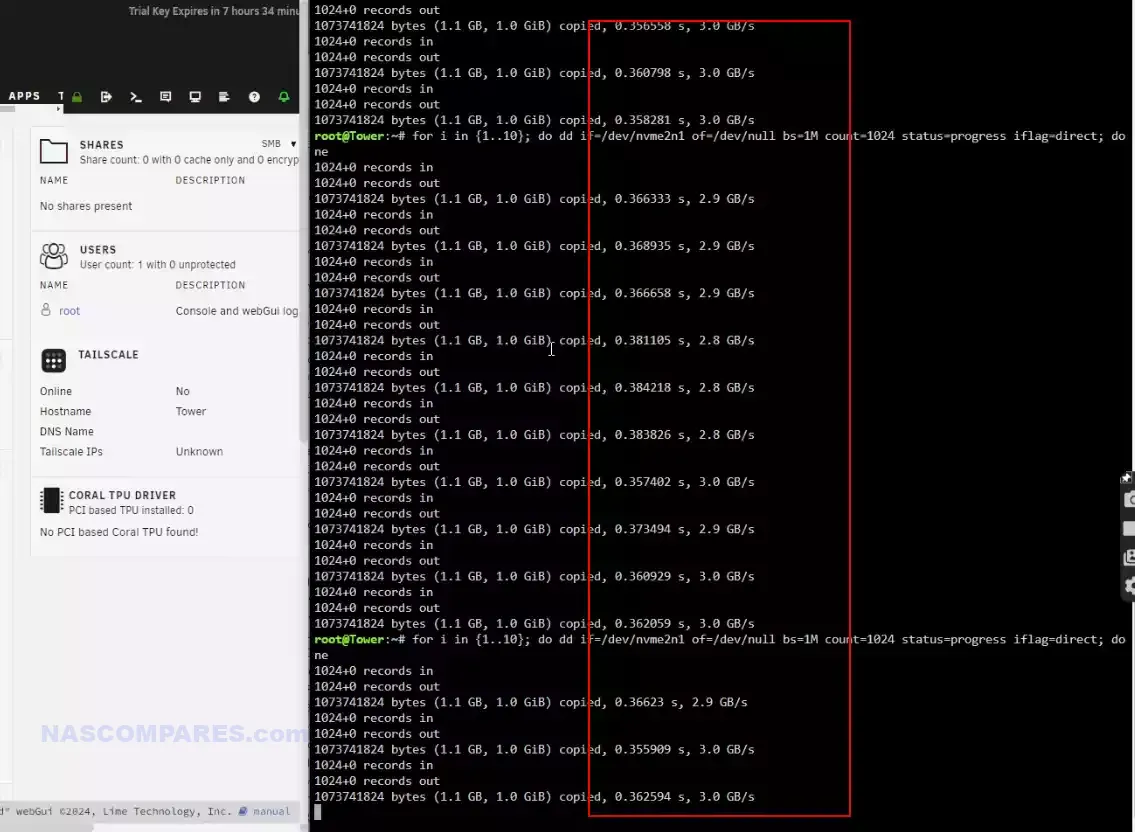
The forced downgrades that kicked in, I am sure, could be negotiated with a better setup and with more time being spent in bios – but those looking at more modest and affordable NAS setups are likely going to lose out on the full abilities of this motherboard. M.2 slots that sharer lanes with the PCIe slot (or even shared across multiple M.2s) are not a new thing, but ultimately you need to keep in mind that this board is not going to immediately give you a perfect system base to work with – it just opens to doors and windows enough to get you on your way, with an M-ITX NAS build.
CWWK Q670 Gen 5 NAS Board Review – Conclusion and Verdict
As long as you do not lose sight of the fact that the CWWK Q670 NAS mobo is designed to be part of a larger and more powerful NAS build, there is ALOT to love here – especially at 200 bucks! For an M-ITX board this thing out specs a lot of bigger and broader M-ATX boards at the price. The Gen 5 architecture, if you are going to build around it ‘hardcore’ enough, as well as spend the time needed to tweak it, is definitely this board’s USP. As is that it manages to challenge conceptions of what an MITX board should arrive with, thanks to those eight native SATA ports. The remote BIOS-level access is a nice extra and although its not going to be used by everyone, in a pinch (ie ‘back against the wall troubleshooting and/or maintenance), it’s a great little bonus. The huge scalability afforded to the NAS builders with the UDIMM memory choice over SODIMM and three M.2s really does allow for a much more aggressively storage-focused system here. All that said, things are super cramped here and extra care is advised when buying your accessories (especially cooling), as aside from airflow restrictions, there is the potential here to accidentally create a air flow dead end! This is NOT a motherboard for the learner homelab’er or shiny new NAS enthusiast… but if you are happy to spend a little more and have the time to configure accordingly, this thing can be a fricking POWERHOUSE!
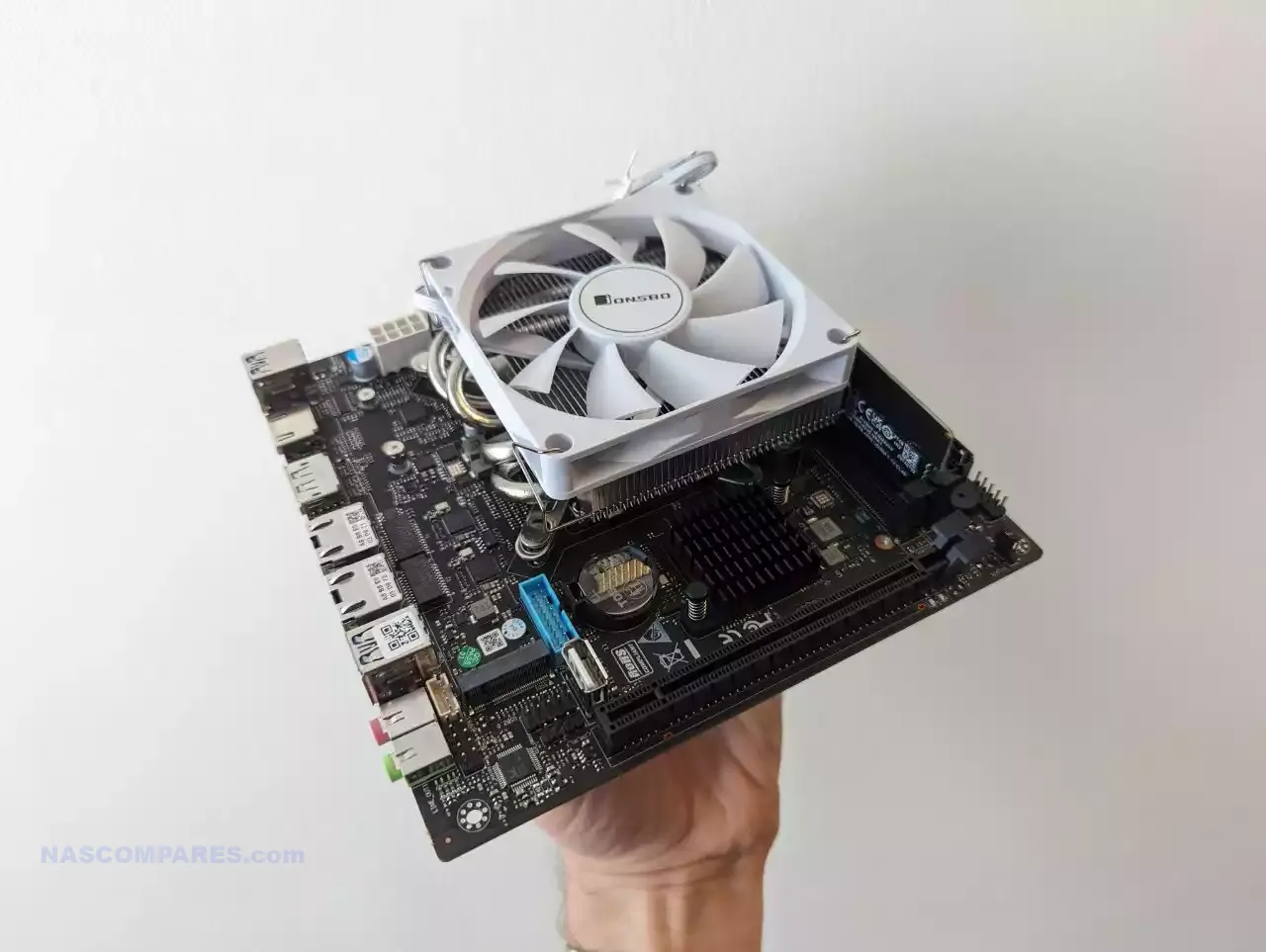
| PROs of the CWWK Q670 NAS Motherboard | CONs of the CWWK Q670 NAS Motherboard |
|
|
|
Where to Buy? |
🔒 Join Inner Circle
Get an alert every time something gets added to this specific article!
This description contains links to Amazon. These links will take you to some of the products mentioned in today's content. As an Amazon Associate, I earn from qualifying purchases. Visit the NASCompares Deal Finder to find the best place to buy this device in your region, based on Service, Support and Reputation - Just Search for your NAS Drive in the Box Below
Need Advice on Data Storage from an Expert?
Finally, for free advice about your setup, just leave a message in the comments below here at NASCompares.com and we will get back to you. Need Help?
Where possible (and where appropriate) please provide as much information about your requirements, as then I can arrange the best answer and solution to your needs. Do not worry about your e-mail address being required, it will NOT be used in a mailing list and will NOT be used in any way other than to respond to your enquiry.
Need Help?
Where possible (and where appropriate) please provide as much information about your requirements, as then I can arrange the best answer and solution to your needs. Do not worry about your e-mail address being required, it will NOT be used in a mailing list and will NOT be used in any way other than to respond to your enquiry.

|
 |
Why People Use TrueNAS, UnRAID and Proxmox to Turnkey NAS (Synology, QNAP, etc)
Why People Prefer Turnkey NAS vs TrueNAS, UnRAID and More
The Top 5 Mistakes NAS Buyers Make
Top 5 PLEX/Jellyfin NAS of 2025
Seagate Ironwolf vs WD Red NAS Hard Drives
The BEST NAS of 2025
Access content via Patreon or KO-FI





Discover more from NAS Compares
Subscribe to get the latest posts sent to your email.


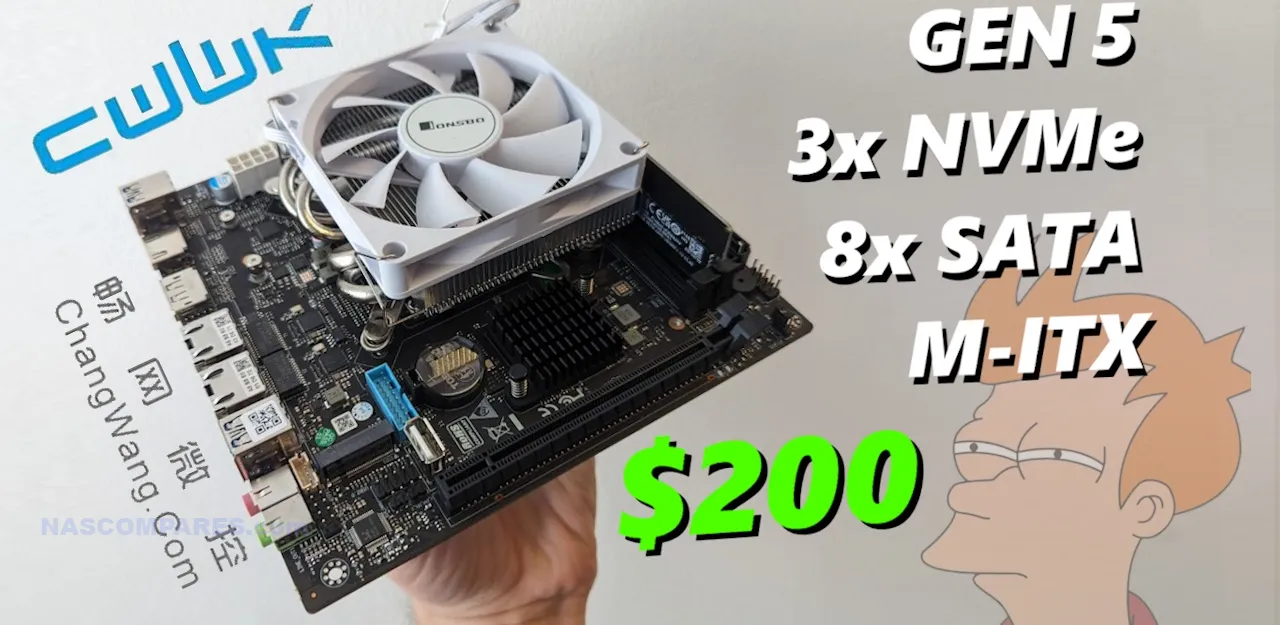
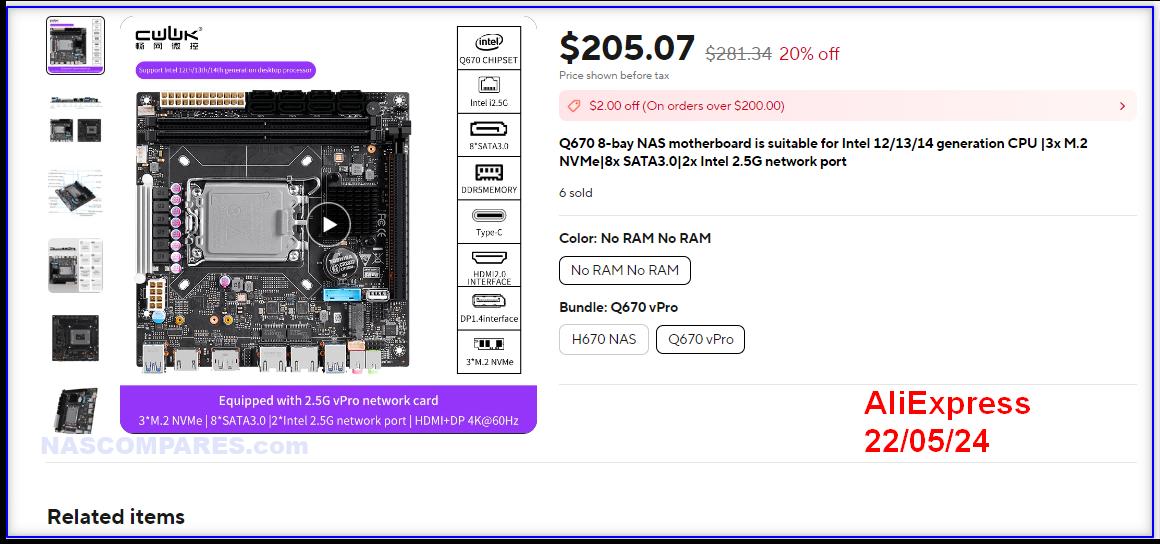



I have this “older” version of the q670. How to i activate the vPro feature? I am running it with a 13500, so it should be available.
REPLY ON YOUTUBE
I am having issues installing TruNas. A lot of ACPI errors. I contacted the vendor on ALI express they sent me a new bios, i’m not convinced it is new, but I cannot figure out how to install. They told me to google it. I tried but with no luck. By any chance do you know how to update the bios for this board?
I’d love to know the powerconsumption of this one. I wonder can i use a GPU card on it too?
REPLY ON YOUTUBE
Seagulls are beautiful.
REPLY ON YOUTUBE
ohhhhh I hope they bring out an imbedded CPU . wondering if should wait or commit
REPLY ON YOUTUBE
Nice try. I may be wrong, but I observe that you and the Chinese manufacturer could’a mentioned that there is no such thing as 2x96GB UDIMM kit available for sale ANYWHERE. You and the manufacturer could’a also clearly specified a Bifurtication feature. Also, what iGPU does this come with? Not your fault because you tried. I believe you. Until I can see more clearly better specifications. I am just not comfortable enough yet to push the buy button. I imagine by April 2025, manufacturing and marketing kittens will open their eyes and mature this product description.
REPLY ON YOUTUBE
I wonder how safe these boards are when it comes to hardware level spyware/backdoors? Have you tested it with wireshark to see if there is any unauthorized communication between it and its homebase in china?
REPLY ON YOUTUBE
CWWK released a new version of this board, a white version with 2 SFF ports which can provide 8x SATA
REPLY ON YOUTUBE
which PSU would you recommend with this board if i want to use 8x22tb drives?
REPLY ON YOUTUBE
Ryzen 5800u on a mini Nuc is cheaper with 16gb ram and dual 2.5G with wifi 6 and 512 nvme. Just add 2 USB 8TB drives and install TruNas. Its 25w TDP and can do gaming with the built in gpu
REPLY ON YOUTUBE
I built my first NAS recently in a fractal 304 case with an old Ryzen CPU and MB I had lying around, problem is it’s only got 4 SATA ports.
I’m trying to decide on whether I upgrade to this and a new intel with an iGPU, or I upgrade to a Micro ATX motherboard with an intel CPU and put it into a fractal 804 :/
REPLY ON YOUTUBE
Hi! Thanks for all your videos, I learn a lot with you. I have recently gone ahead with a Jonsbo N3 + CWWK 8505 motherboard. I have configured everything and it works great with Unraid, except fan control. I have switched all the fans in the case to PWM but regardless of whether or not I activate the dynamic control system and its thresholds in the BIOS, or even setting the fan control to a manual PWM value does not generate any change in their behavior, they continue to run at the same speed. I don’t know if I should update the BIOS or what I should do, but I can’t find any documentation or link to a more updated bios version either. If you could help me I would be very grateful. Best regards.
REPLY ON YOUTUBE
Any micro atx in this similar configuration? Will be using it in the Jonsbo N5
REPLY ON YOUTUBE
I have been dying to build myself a decent nas for about 5 years now (not including splurging money on used servers/workstations which cannot be run 24×7).
The motherboards that cost $200 cost $500-700 used in India. At this point I am beyond frustrated. Time to start looking for that long lost friend who settled abroad to bring back a decent MOBO on his trip back home.
REPLY ON YOUTUBE
Moore Donna Jackson Amy Perez Patricia
REPLY ON YOUTUBE
Clark Donald Martinez Maria Taylor Ruth
REPLY ON YOUTUBE
Where would a NAS with this much speed, memory and processing power be used?
REPLY ON YOUTUBE
Hi! I assume that this board is made in China? I don’t´t trust and don´t want to support China in any way if possible. I really would like to see a video like this (or diy nas in general) but parts that don´t came from the greatest country on earth. Cheers!
REPLY ON YOUTUBE
Rodriguez William Johnson Ronald Harris Jessica
REPLY ON YOUTUBE
White Melissa Moore Scott Brown Charles
REPLY ON YOUTUBE
Excuse me, 3 what (hundred)? May I purchase a normal motherboard with 4 sata for $50, a normal cpu for $50, a pcie to sata for $20 into one slot, a pcie to nvme for $20 into another one, and be happy. Because 6-8 3.5″ drives require so big case, and psu, that literally any motherboard will fit.
REPLY ON YOUTUBE
Wanting to build a 10Gbe NAS with 2 x 2Tb NVME and 4 x 10Tb Rotating Rust. I am trying to figure out how to make the 4TB NVME as a cache fronting the older HDDs. And in the interests of low noise and low power, the 40Tb HDDs should spin down unless absolutely need for a transfer. Does such a thing exist? Thank you for reading this far.
REPLY ON YOUTUBE
171 Schmidt Lake
REPLY ON YOUTUBE
405 Felipe Bridge
REPLY ON YOUTUBE
Moore Larry Miller Susan Perez Matthew
REPLY ON YOUTUBE
wow~Our already have restocked
REPLY ON YOUTUBE
i just got the board but i cant seem to find any drivers, there was no cd in my package and on the offical page has only a Bios in it’s bios/driver link. CWWK chinese service download site https://pan.x86pi.cn/ has as far as i can see with goole lens altough nothing. can anyone please help me?
Jones Anthony Hernandez Michael Martinez Susan
REPLY ON YOUTUBE
Thanks. But this video leaves a few things to be desired.
It would be nice to see a full blown set up with this motherboard being fully populated
REPLY ON YOUTUBE
Will a intel pentium 12/13/14th gen work on it as well? ????
REPLY ON YOUTUBE
Will you please post a full build for this board? Thanks
REPLY ON YOUTUBE
I just got this board and cannot get any of the m2 slots to work. And cwwk isn’t responding after over a week
REPLY ON YOUTUBE
Very curious what idle power can be achieved. Can this even get to low c states? The bios spaghetti does not inspire confidence…
REPLY ON YOUTUBE
I just ordered the Board. Can you recommend some CPU coolers that won’t block the udimm slot?
I planning to use a jonsbo n4 – since the n3 will take a month or so. Maybe i will get the n3 anyway but if the n4 is the only option i have to fit a top blower cpu cooler.
Any recommendations?
And did you try the intel stock cooler?
Thanks for testing and thanks for your review post!
REPLY ON YOUTUBE
Looks really similar to the Piesia NAS-H670(R100) albeit in a black motherboard color.
REPLY ON YOUTUBE
I was interested in their 4 bay nvme but Lots of reviews saying various CWWK NAS boards & routers etc stop working soon or arrive with some chip (function) not working. This workshop should focus on quality control more, need reputation to grow, not quick bucks by any means necessary. I’ll stick with glinet products.
REPLY ON YOUTUBE
45w ? Hmm … Was it on idle ? If not then that board isn’t suitable for the EU
REPLY ON YOUTUBE
I got this board, plus an i5 12500T from AliExpress. The board did not want to boot, it beeps when I power it on. CWWK support said that either memory is incompatible or CPU is not seated correctly. Board keeps beeping even without the memory installed.
I am returning both the board and the CPU, even though it is more likely the board is bad.
Anyone else had an issue like this?
REPLY ON YOUTUBE
please wipe your camera lense or open a window – else… thanks for the great video! 🙂
REPLY ON YOUTUBE
Thank you for the video – Newbie question – For a newbie, installing Truenas Scale on a board like this with the 3 M2.nvme slots – what would you do for the boot drive/s ? I have read it is recommended to have a mirrored config, but then I also read the boot drives can only have the os on them ..
REPLY ON YOUTUBE
We need the review of this board ASAP!
REPLY ON YOUTUBE
i cant seem to find any information or user manual on this bord. any one know of one? im would like a definate answer on bifurcation supprot
REPLY ON YOUTUBE
has support for Windows server 2022 standard?
REPLY ON YOUTUBE
I’d love to see a picture of how the headers hooked up. I’m trying to get one of these to work nice green light on the MB, but the switch won’t work for me to power up. 🙁
REPLY ON YOUTUBE
@nascompares Is there an option in the UEFI to limit the cpu power consumption in turbo mode?
REPLY ON YOUTUBE
on the one hand they left the whole reference bios untouched and open to the buyer
on the other hand, they definitely didn’t do any test all those features. or indeed any of them i suspect.
let alone combinations of features.
its got an attractive set of ports and slots, but you would want to do some seriously stress and fault testing if you were going to use this to store critical or irreplaceable data.
REPLY ON YOUTUBE
Imagine it was 4xgen3 drives on the back rather than 2x gen4 drives, sure it would need a 4.0 to 3.0 multiplexer but still that’d be pretty cool.
I wish Optane hadnt died out, would love a gen5 optane drive to go in that 5.0 slot with 7GB/s and near RAM latencies for a special metadata drive, though for special metadata you really should have 2-3 drives.
REPLY ON YOUTUBE
Not a bad price, i remember picking up an asrock rack X470 mATX board with dual LAN and IPMI for around $260, boy was i ticked when the one with dual 10G went on sale for $299 and then shot back up to $500+ before i realized.
REPLY ON YOUTUBE
Like this board! Based on you review I’ve purchased the H670 version and set it up with an i7-13700T, 96GB (2x48Gb) memory, 4x-mirror mode spinning disks, nmve SSDs and a Mellanox ConnectX-4 single 100Gbe.
What I noticed though is that the single PCIEv5 slot shares recources with memory; when using the Mellanox NIC card (PCIEX 16x) the system will only read half of my memory and ignores the second bank. Switching to a ConnectX-3 card (PCIEX3 x8 2x10Gbe) it does work again…..
I’m now trying to figure out how I can force the PCIe slot to work in PCIe 8x mode (as the 100Gbe Mellanox is a single 100Gbe one) but as you’ve mentoined, BIOS settings on this board are quite elaborate…. If anyone knows what settings to look at or play with I would appreciate that.
REPLY ON YOUTUBE
Have a 13700k. Have 8×16 tb hdds. Was thinking about this board or the meg z690i. Which is better in your opinion?
REPLY ON YOUTUBE
I’m reeeeally looking for something like this, but for AM4, so i can put my 3950x to use 🙁
REPLY ON YOUTUBE
I’m also interested in this tiny beast, but I’ve got two major questions. What Sata Controller does this board use? JMB or AsMedia? Want to use it with unraid and the JMB often causes problems with power efficient builds. Second: how good are the VRM, the data sheet said max 65 Watt TDP, is it usable with an 14600 or higher, or are we stuck with the “T-Series”?
REPLY ON YOUTUBE
Ok why do all the systems you recommend have to be tiny Motherboards?
I have room as do most people for a full sized computer do you have any videos where you recommend atx or even eatx boards?
I find the one pci slot on these boards annoying.
Is there a video I am missing?
REPLY ON YOUTUBE
The AliExpress links don’t work for me. Do they work for anyone?
REPLY ON YOUTUBE
When will we get a ‘smallish’ system with at least 4 NVMe Gen 5 x4 slots and ECC support?
REPLY ON YOUTUBE
Quite fancy one of these.
REPLY ON YOUTUBE
Word for thoughts to 0hraseth3 math into language common up
REPLY ON YOUTUBE
AC to SC from DC to ERf split the audio into 2hub avi channels btle the audio and jack the video using red-ultra and direct the load to local motor batt and feed generator overtick to bay field battery and garage outhaust and waste or straight down the drain pipe if ceramic with as it is service box treatment wifi over the electric over btle and red light multi accutrainable semi conduct directional ocusig and direct load energy as packets of dloadable energy. Watss son
REPLY ON YOUTUBE
I’m looking for something similar but full-size ATX with a few extra pci slots. Recommendations?
REPLY ON YOUTUBE
To me THE number one limiter in “NAS” boards these days is networking. This board should ABSOLUTELY have a 10gb NIC built in and a 1gb Management port. 2.5gb is outdated AF for “do it yourself” NAS’s. Especially when the board has so much high speed storage capability and so much bandwidth available from the CPU.
The PCIe slot should NOT be 16x. It should be 8x. PCIe 5.0×8 is more than enough bandwidth for literally anything you want to put in that slot. Including even the latest most powerful video cards. And the PCIe 5.0 M.2 is also a pointless waste on a board made for NAS’s. Should have just been another Gen4x4 or even 2 more Gen 4×4’s for the same bandwidth.
The extra bandwidth should have been dedicated to 10gb networking and perhaps even some U.2 or Mini SAS or even both.
The slot NEEDS to be left available for Storage, HBA’s or a GPU for compute or encoding/decoding. But with only 2.5gb, you would have to waste the PCIe5.0 slot on simple bloody networking.
I keep seeing these boards come out and only ever be NEARLY the perfect home server board. And this is once again the case. How do manufacturers consistently continue to fail in this arena.
This board could have been excellent if only it had friggin 10gb onboard. What a shame, what a waste.
This board is a big “BOOOOOOOOOOOOOOOOOOOOO” from me. Such a shame.
REPLY ON YOUTUBE
Still planning out my NAS rebuild, I’d love to see one of these manufcturers put a 10gbe/SFP+ port and make the board a little bigger with 2 X8 slots instead of 1 X16 and all the M.2 on top. It’s hard to cool some of the hotter running gen4 drives when it’s on the bottom of the board. That said the addition of vpro is pretty huge, if you can live with the 2.5gbe this isn’t bad for the money.
REPLY ON YOUTUBE
If you hate seagulls, then I have the perfect video for you. https://youtu.be/U9t-slLl30E?si=YnqO1bNwD3cC0ZYK
REPLY ON YOUTUBE
I’d guess, if you populate then gen5 M2 slot, you will lose 8 lanes on the x16 slot. Intel does not have own gen5 PCIe lanes for SSDs like AM5, so board manufactorers need to chop them of from the GPU lanes by bifurcation. Means: placing a SSD of any gen in the gen5 M2 leaves you with a x8 PCIe only slot and that is not possible to bifurcate anymore. Every other Intel 1700 board works that way because of the CPU limitation.
REPLY ON YOUTUBE
This looks Great to build my N3 NAS, just a quick question, since you know the N3 and this board, what is the best/biggest CPU Cooler to get to avoid interfering with RAM or PCIe Slot?
I’m thinking on going with i5 12500, unless you can provide a better recommendation.
Thanks in advance for your advice and of course, looking forward to see the Build 🙂
Cheers
REPLY ON YOUTUBE
What do you mean by Gen 5?!
Gen 5 Intel?!
Gen 5 DDR?!
WHAT?!
REPLY ON YOUTUBE
This asks for a Jonsbo case. Perfect match.
REPLY ON YOUTUBE
Can you explain the whole “low power CPU (T series) suggested” thing works? Shall my i3-14100 cause the VRM to fry?
REPLY ON YOUTUBE
The effort is nice but the result… If this could had at least 1 more PCI-E slot even x8 would be so nice. Also memory slots would be nice to be more than these 2 🙂 So for example if NAS could support at least 256 GB memory, 100Gbe NIC and 12G sas adapter all at once then it’s the working choice, otherwise no thanks 🙂
REPLY ON YOUTUBE
can the x16 slot be bifurcated to x4/x4/x4/x4 ?
REPLY ON YOUTUBE
Can you make any motherboard recommendations for SAS drives, or a decent motherboard with space for a SAS controller card? Love your videos!
REPLY ON YOUTUBE
When there’s a AM5 or AM4 equivalent wake me up ????????????
REPLY ON YOUTUBE
So what’s the difference between the NAS Board-Q670+vPro and the NAS Board-Q670? About 30 bucks difference but I can’t find a difference at least on the Amazon listing.
REPLY ON YOUTUBE
Pointless unless you have 25gbe minimum
REPLY ON YOUTUBE
Great video! When you do a build with this motherboard can you take a measurement of the watts during idle and load?
REPLY ON YOUTUBE
Can’t wait for the follow up. Thanks ????????????
REPLY ON YOUTUBE
H670 is model without intel vpro and is about $20 cheaper. Also vrm doesn’t support high end cpus, 13500t is recommended cpu.
REPLY ON YOUTUBE
Can the x16 slot do dual x8 bifurcation? Also the link on Ali for this motherboard doesn’t work for me and can’t find it anywhere searching for it manual on Ali.
REPLY ON YOUTUBE
nice MB.
REPLY ON YOUTUBE
Great video as usual, thanks for the test bench idea, https://youtu.be/Fp-LmI3W6IE?t=104
REPLY ON YOUTUBE
Been looking at this board for a Jonsbo N3-build. But that RAM-slot looks really tight by the cpu cooler. No real need for the PCI-E slot or the gen5 port. But the BIOS looks a bit intimidating for a first build. Would you still recommend this board? As for now I’m looking at Gigabyte B760I as an alternative.
REPLY ON YOUTUBE
200$ is pretty premium price for a Chinese Motherboard
REPLY ON YOUTUBE
Hi I have a spare i8700k on a m-atx mother board. I wanna do a proxmox machine out of it, any recommendations for a matx case?
REPLY ON YOUTUBE
just saw this board a few days ago on another channel. this board is the final puzzle in my plan to build a Jonsbo N3 multimedia server
REPLY ON YOUTUBE
I gotta make a point of watching these vids on Kofi. By the time they get here the kits not available. :/
REPLY ON YOUTUBE
ECC support? Curious to see the list of supported CPUs
REPLY ON YOUTUBE
Thanks for a review! Really interested to see how this all work together in that video in the future! I am actually waiting this board to be shipped now 🙂
REPLY ON YOUTUBE
I added this board to my wishlist, i’ll watch other video to see if it’s good or nah
REPLY ON YOUTUBE
CWWK missed the mark. Maybe if it had a built in mobile CPU at that price it would satisfy some needs… but for $200 you might as well get a bigger motherboard and not kneecap yourself with expansion especially for 100G networking and a 16 drive HBA. ITX is great and all but if you are putting 8 drives into a case, you probably have room for a full sized motherboard.
REPLY ON YOUTUBE
Probably best itx board ever made. The fact that you can get vPro on it is fantastic. The only thing they could of done to make it perfect is add 10Gb. You can use a different cooler that extends higher if are worried about not fitting everything. Plus gen5 nvme for nas really isn’t noticeable even if you had a 25Gb nic. Save some power, heat, and money using gen4.
REPLY ON YOUTUBE
Can’t wait to see the full build ????
REPLY ON YOUTUBE
I always aim for matx, but this genuinely would allow some shrinkage without making sacrifices, assuming everything fits.
REPLY ON YOUTUBE
Why trusted brands don’t make some of these boards.. I want this but from ASUS..
REPLY ON YOUTUBE
What a great board for NAS/Homelab build.
REPLY ON YOUTUBE
Super interesting Board ????
REPLY ON YOUTUBE
Love your videos
REPLY ON YOUTUBE
Sweet
REPLY ON YOUTUBE
*SORRY* for the hazy lighting on this video! It was recorded JSUT before I headed to Taiepi for computex and my ‘good kit’ was all packed up and I was relying on my backup kit – which had a faulty light sensor that failed AFTER I checked everything was up and running.I plan on returning to this board for a larger video soon, and I will be double…no…TRIPLE checking the light levels on that one!!!!!! Have a great weekend all.
REPLY ON YOUTUBE
I own the H670 version without vPro and am also very impressed.
However I noticed that it is apparently not possible to enable the tunables for both NICs via powertop (e.g powertop –auto-tune), otherwise the system freezes. Have you been able to test and confirm this? I have already reported this problem to CWWK, but have not yet received any feedback.
We have not tested this. Please share your feedback when you get a response.
Is it possible to use like a 14700k or 14900k with this mobo? I am thinking about a 240 mm AIO instead of an air cooler since the pump that gets placed on top of the cpu is smaller.
Here is a list of supported CPU for this socket- lga-1700
https://www.awd-it.co.uk/components/processors/intel/socket-1700-alder-lake.html